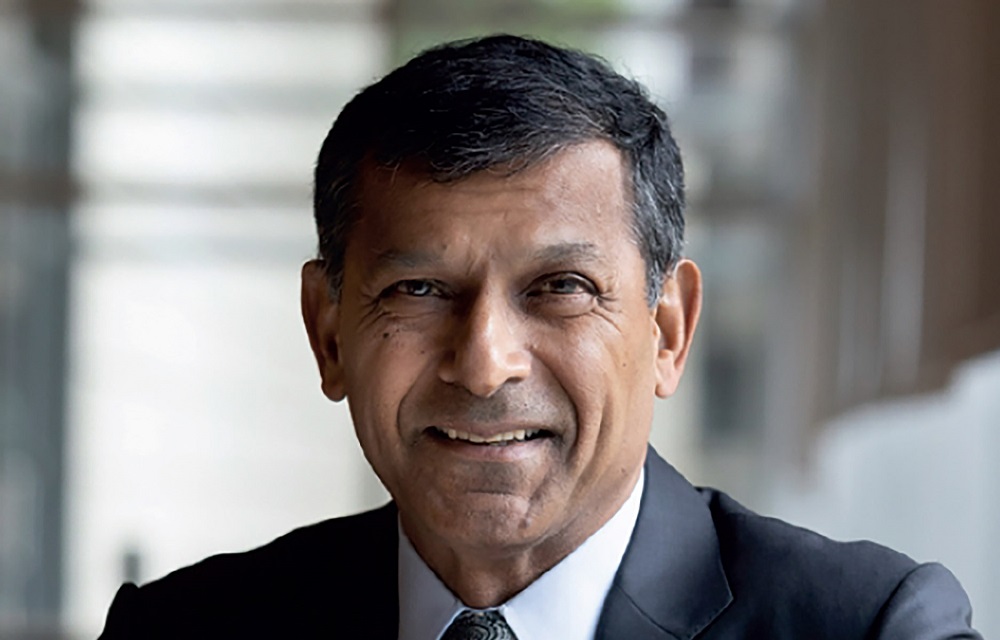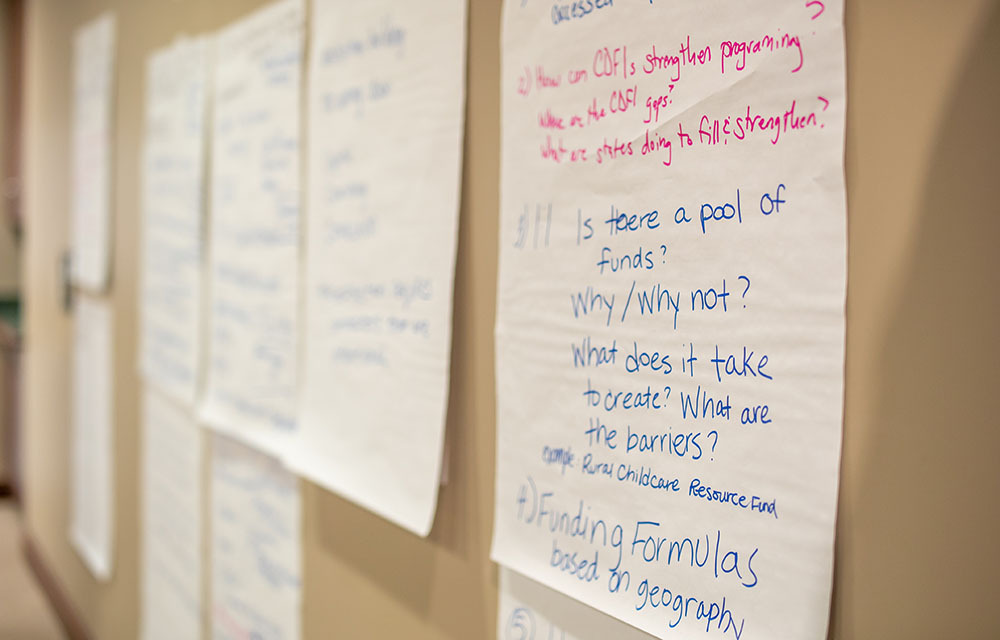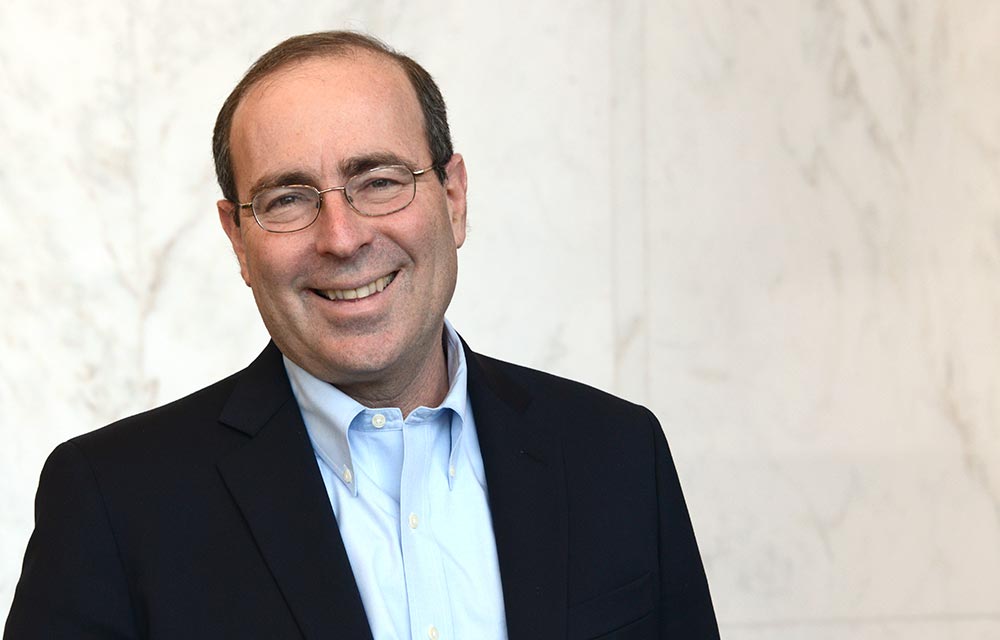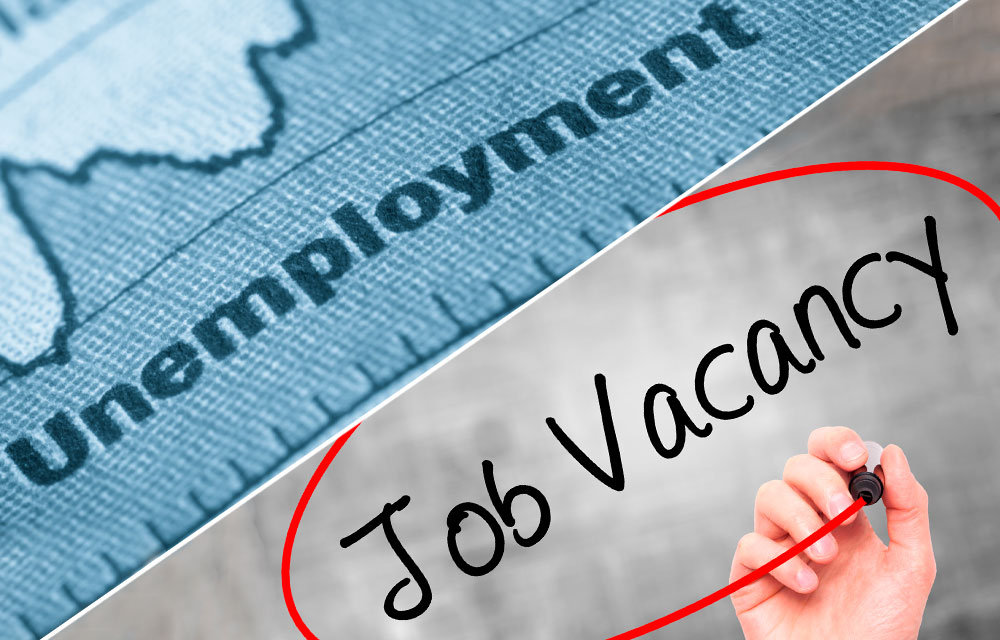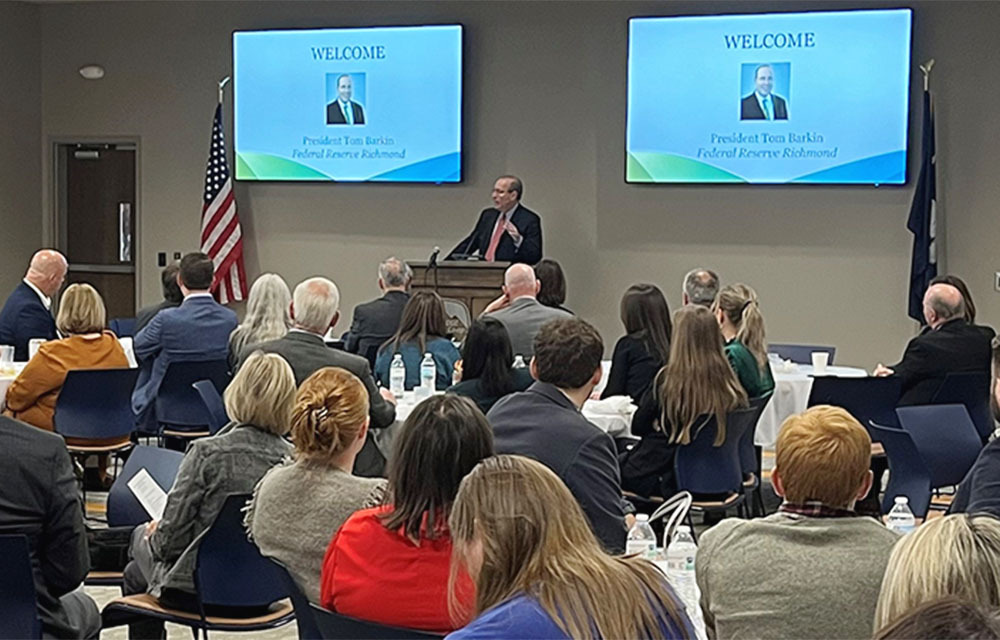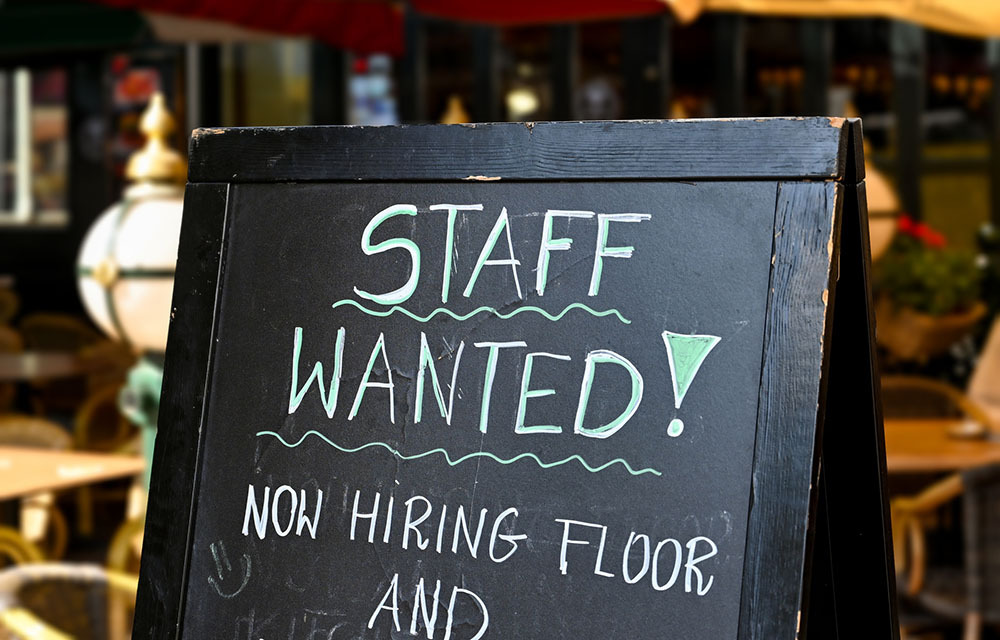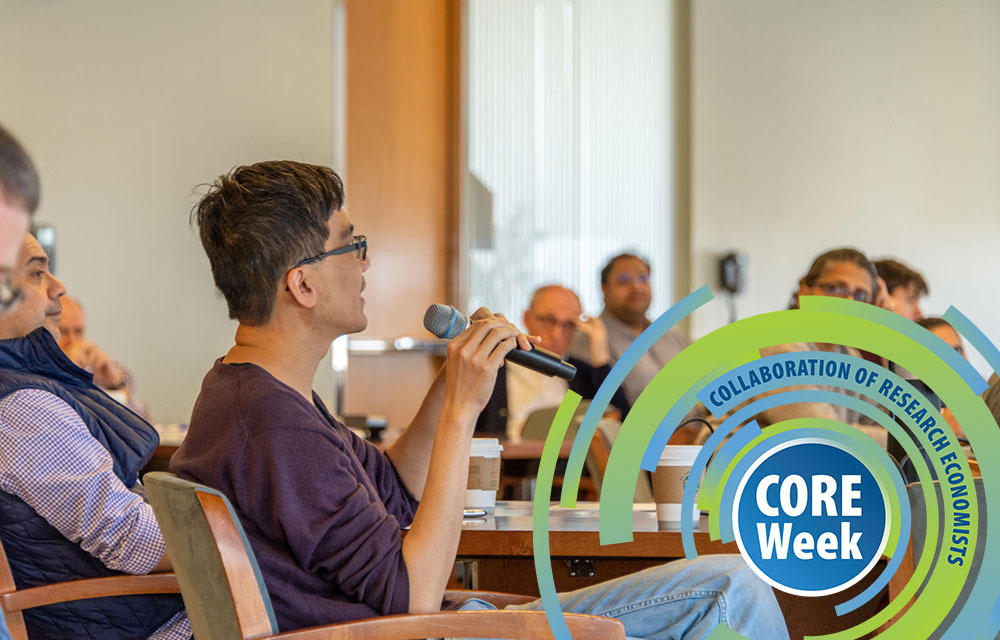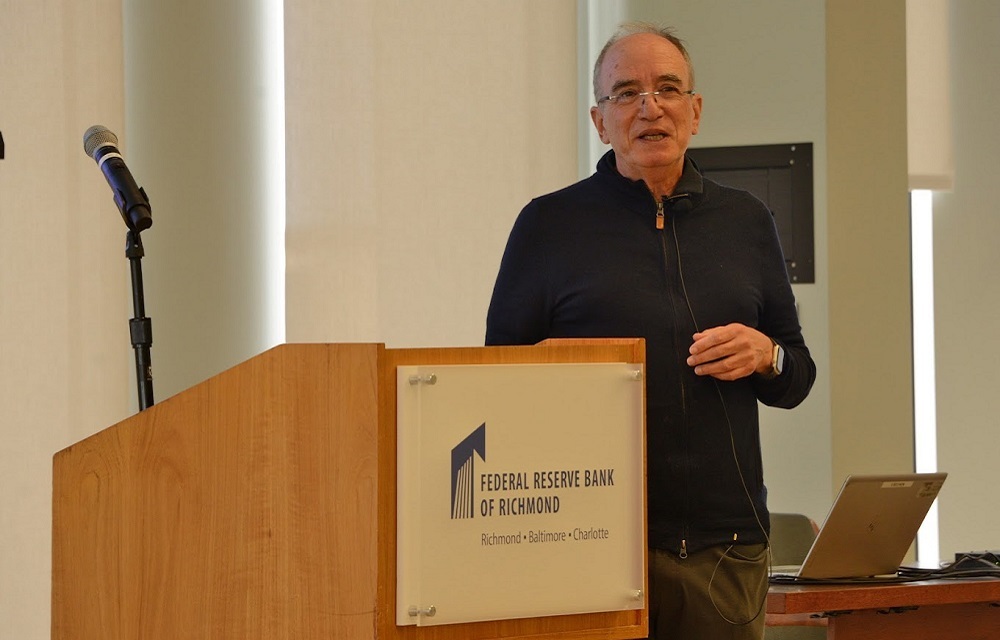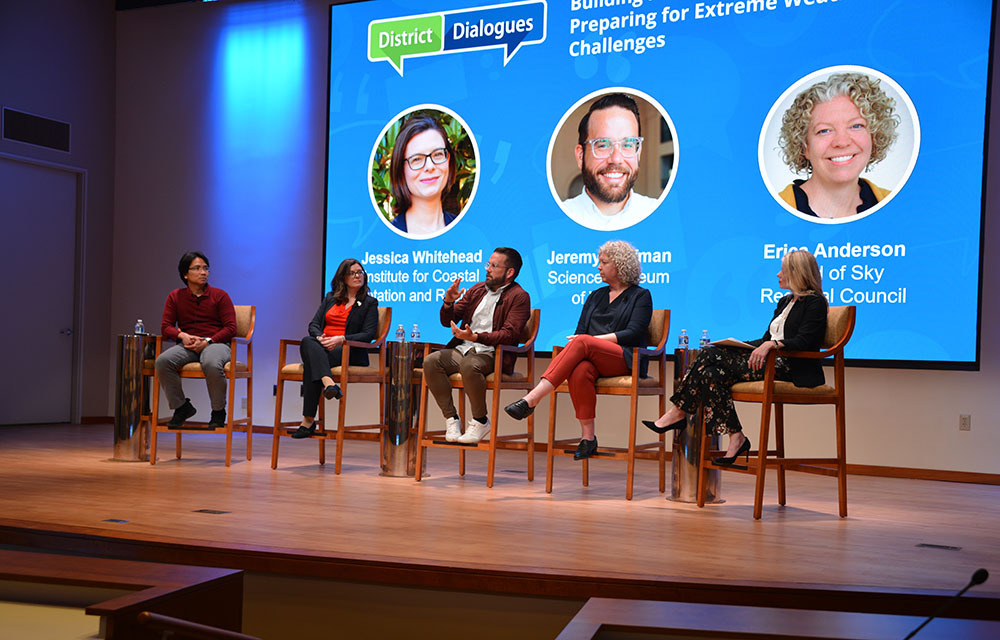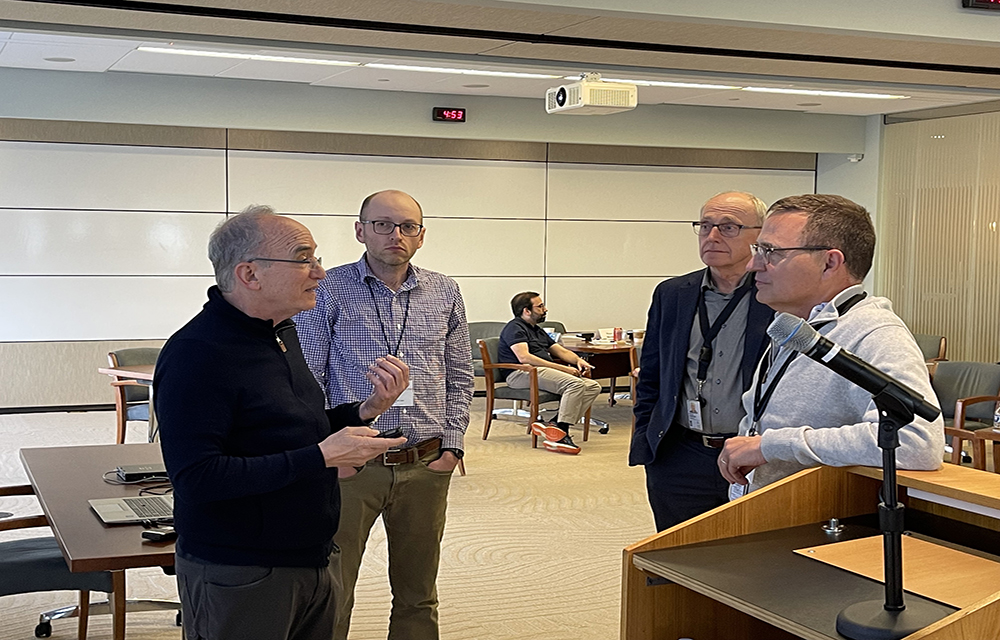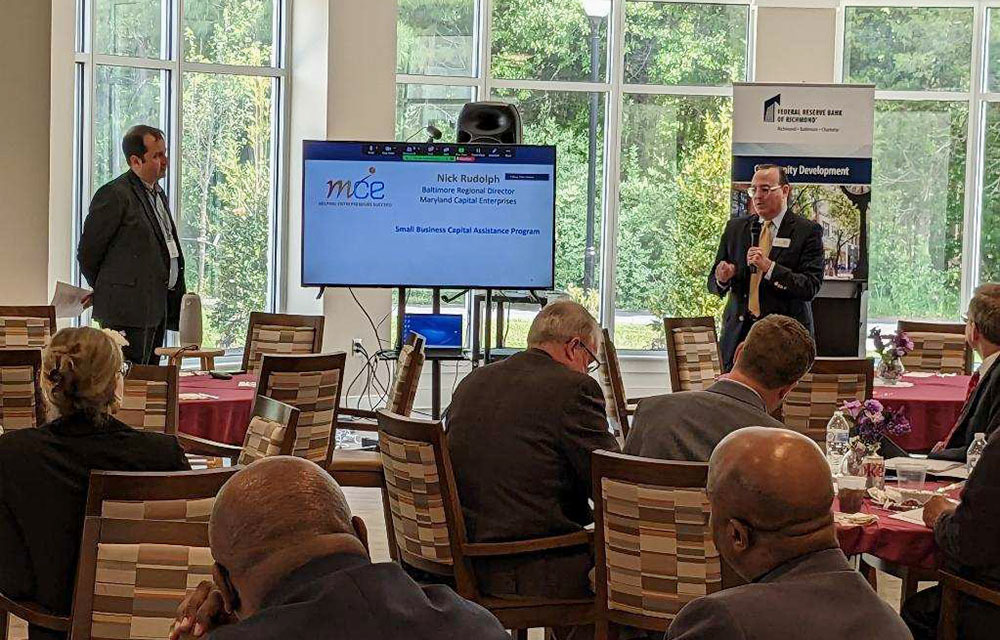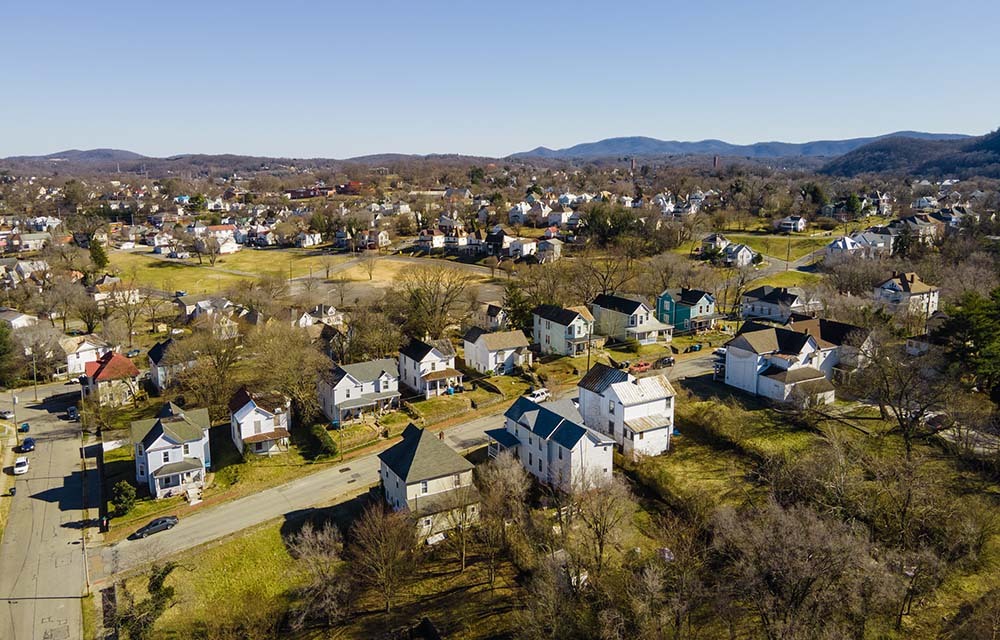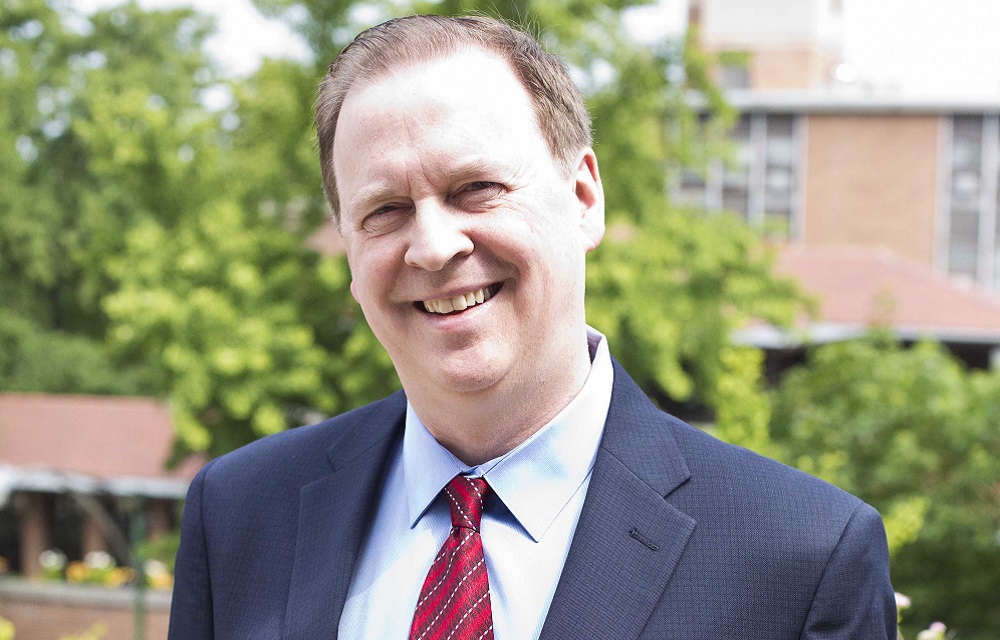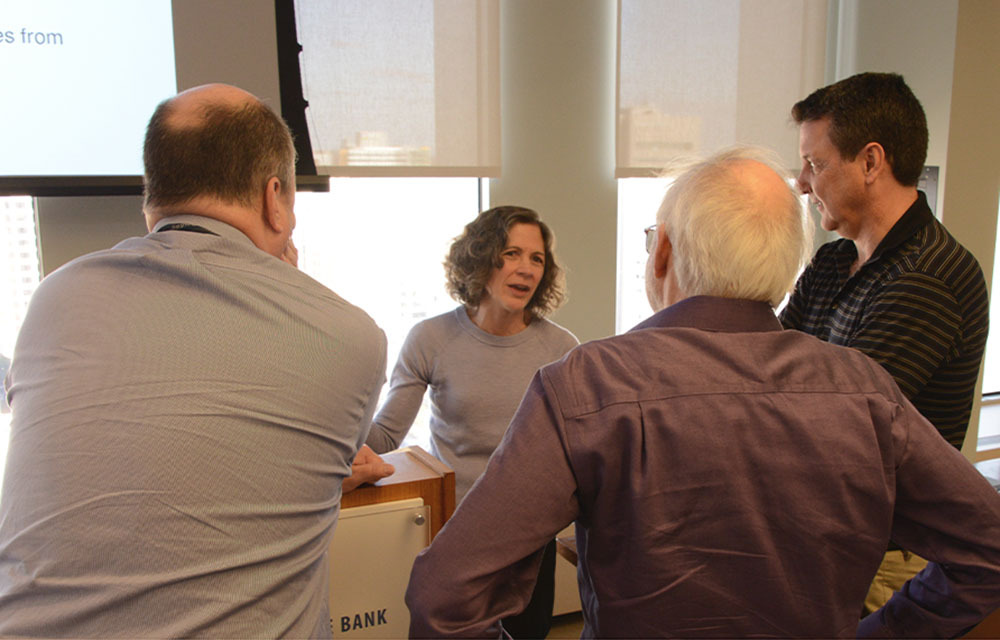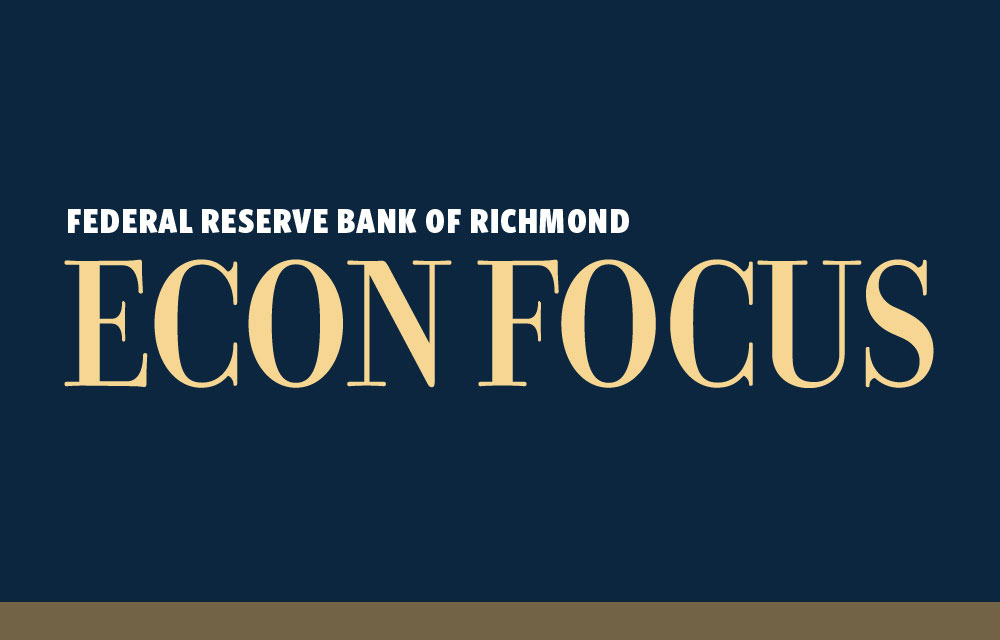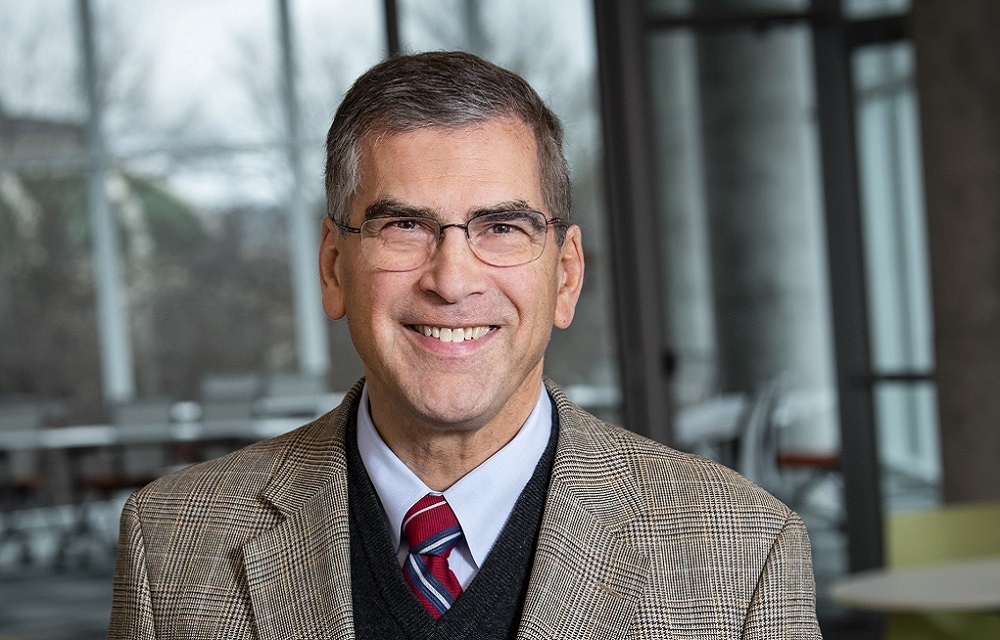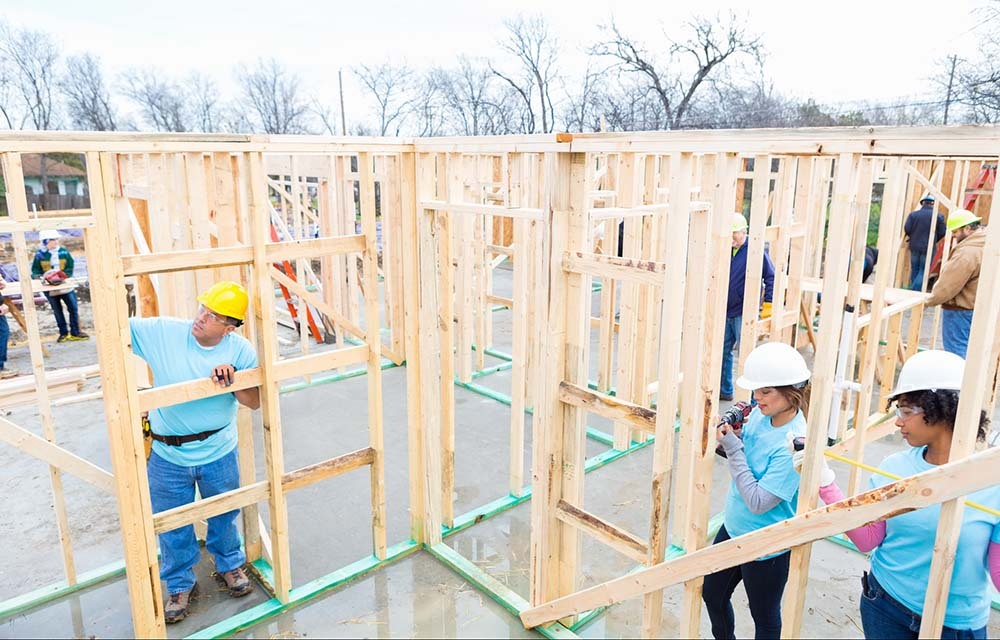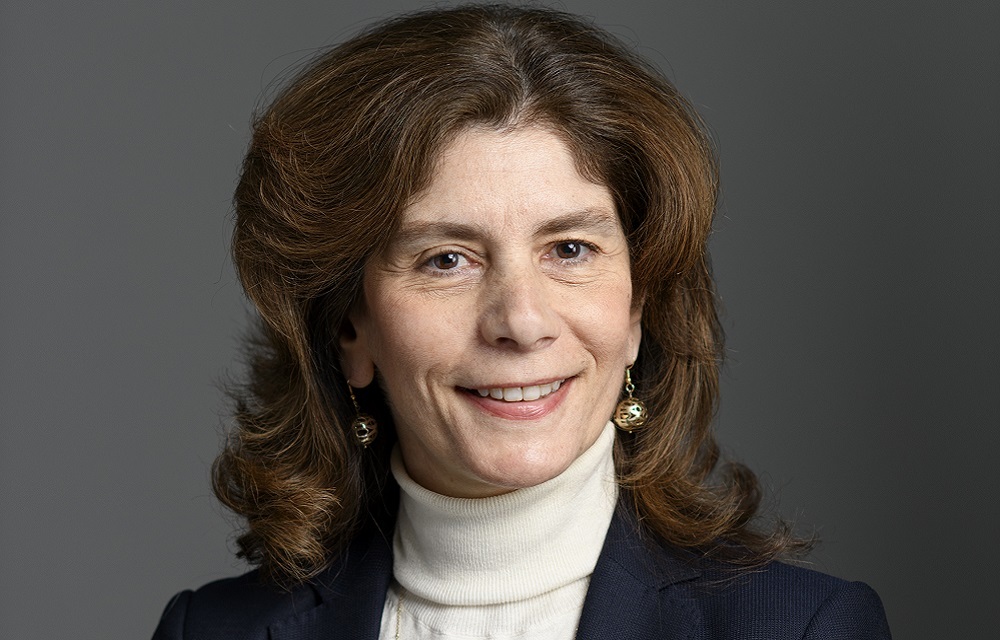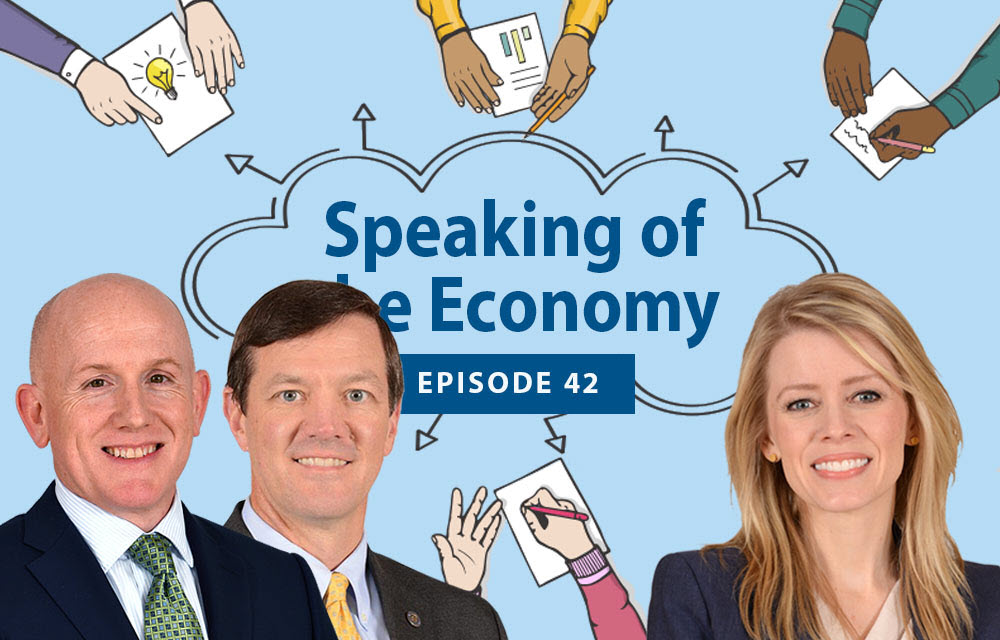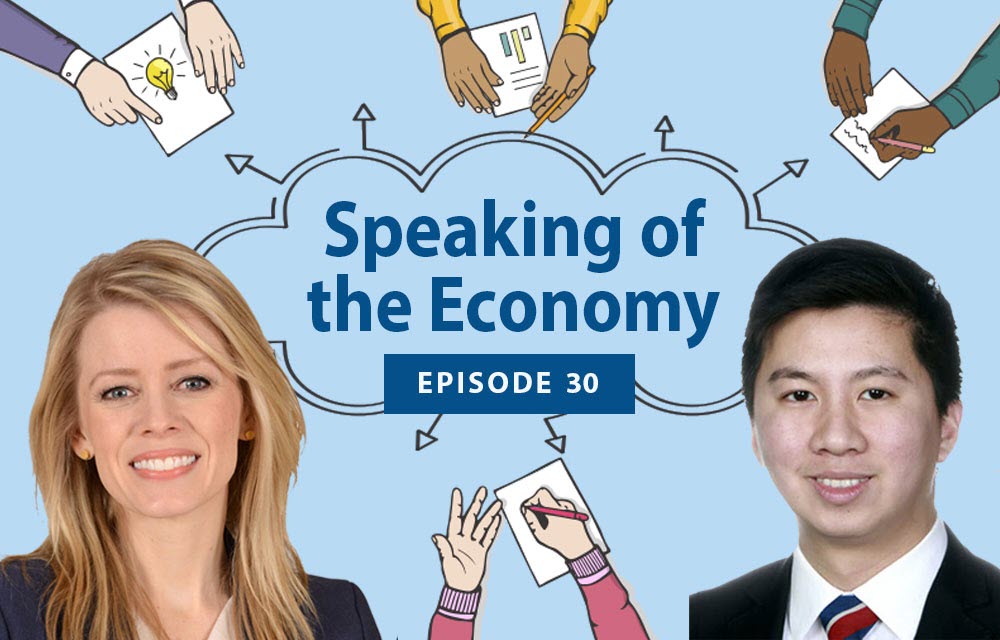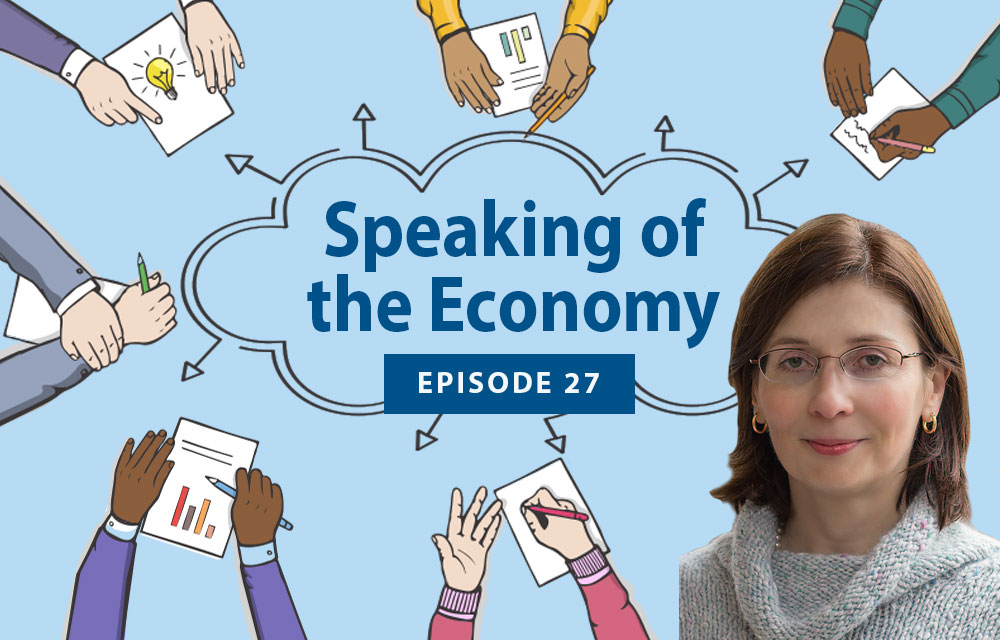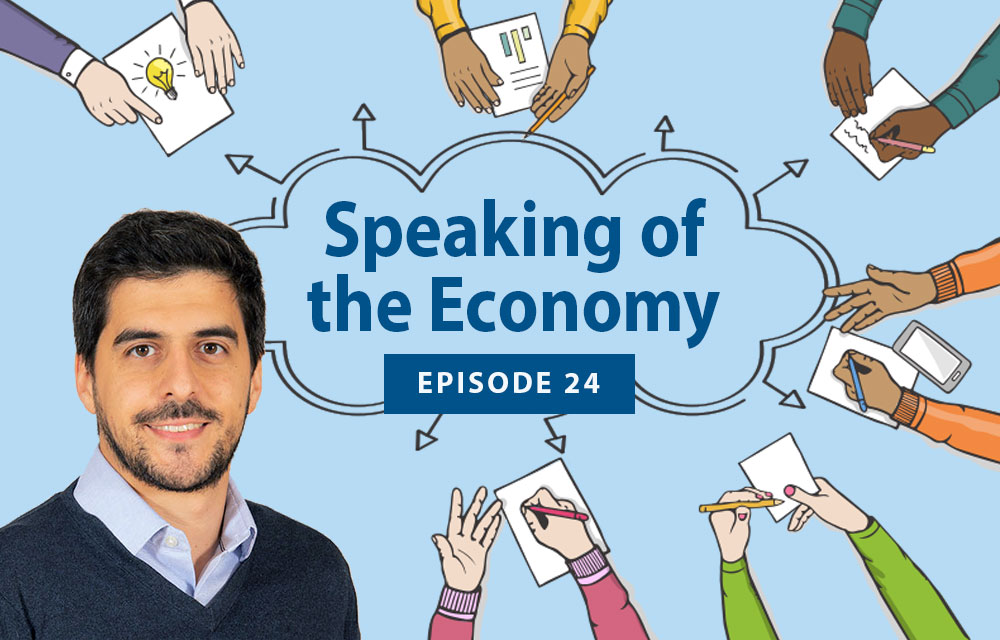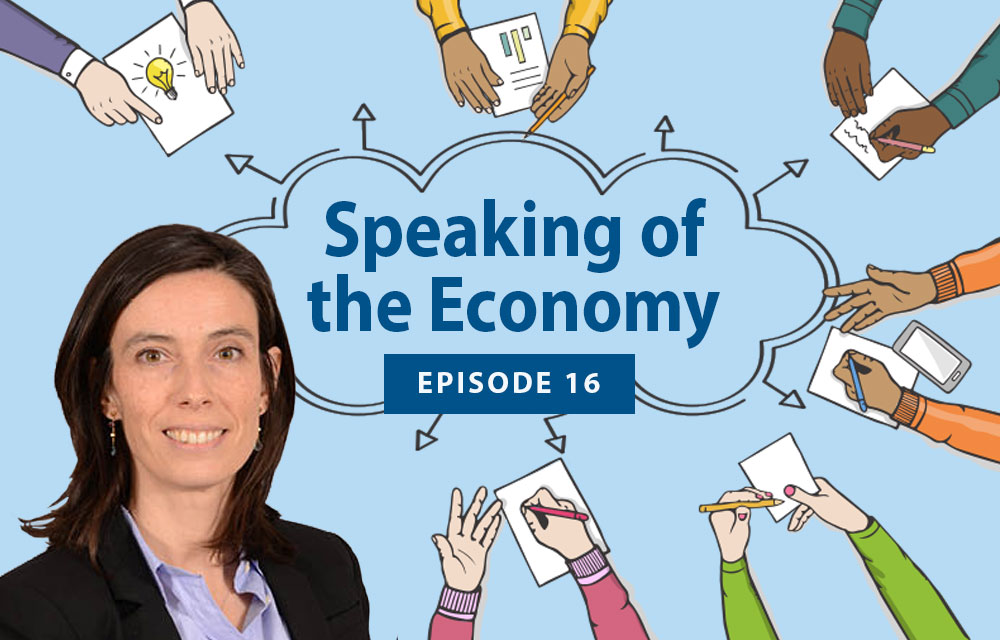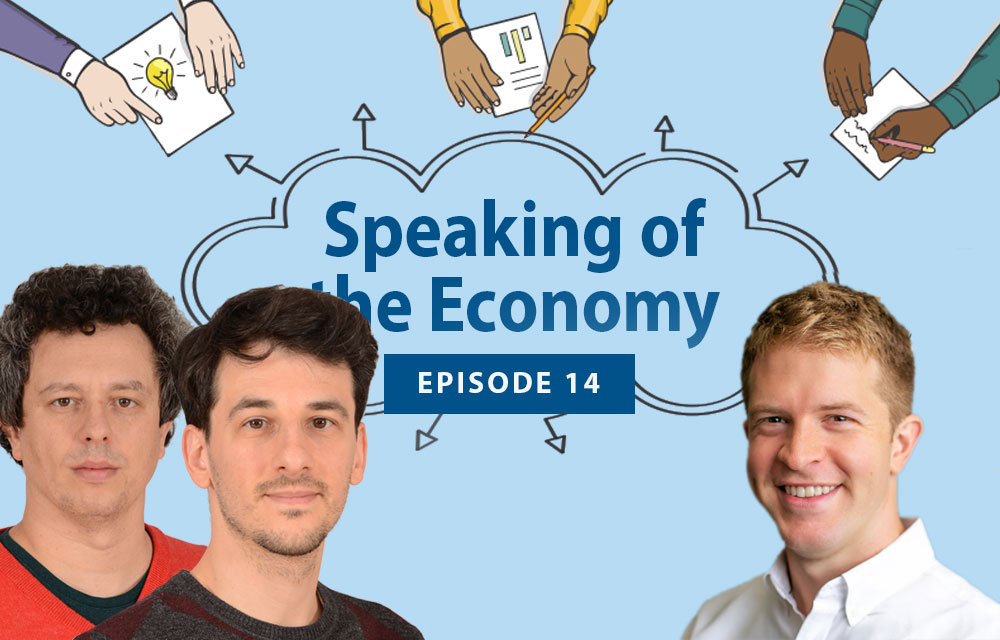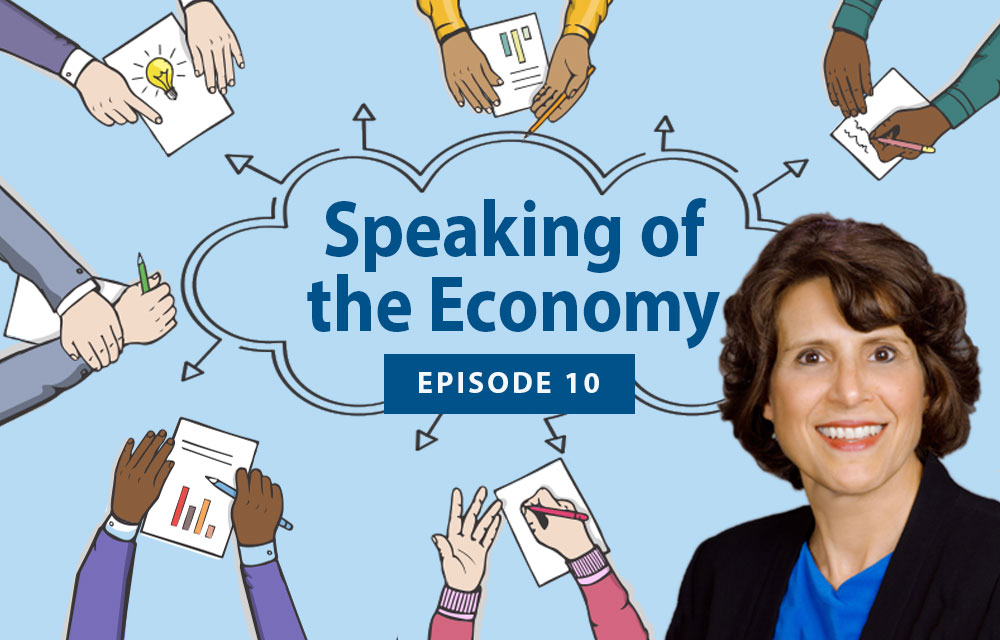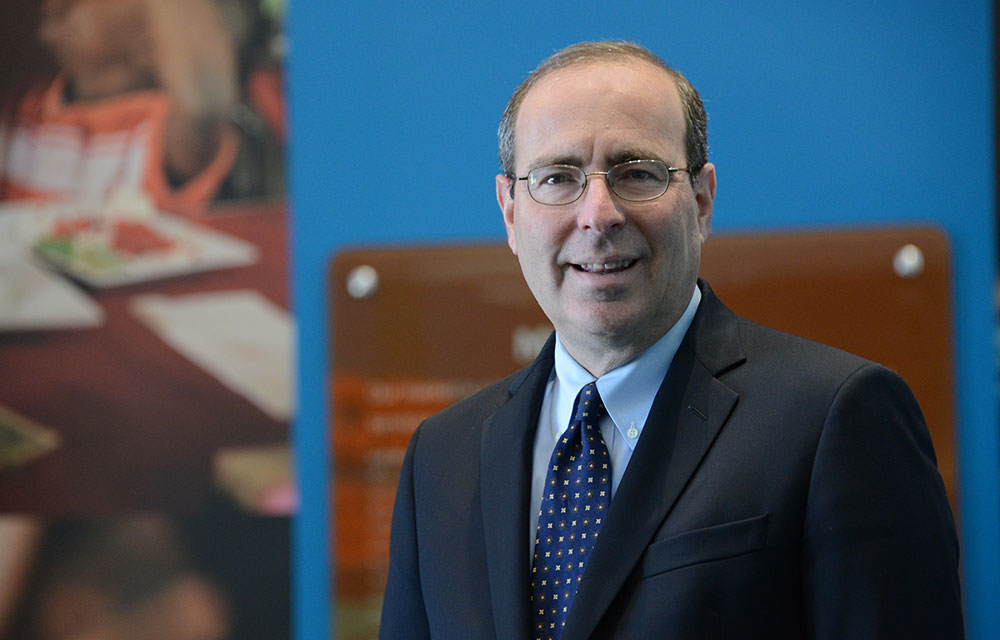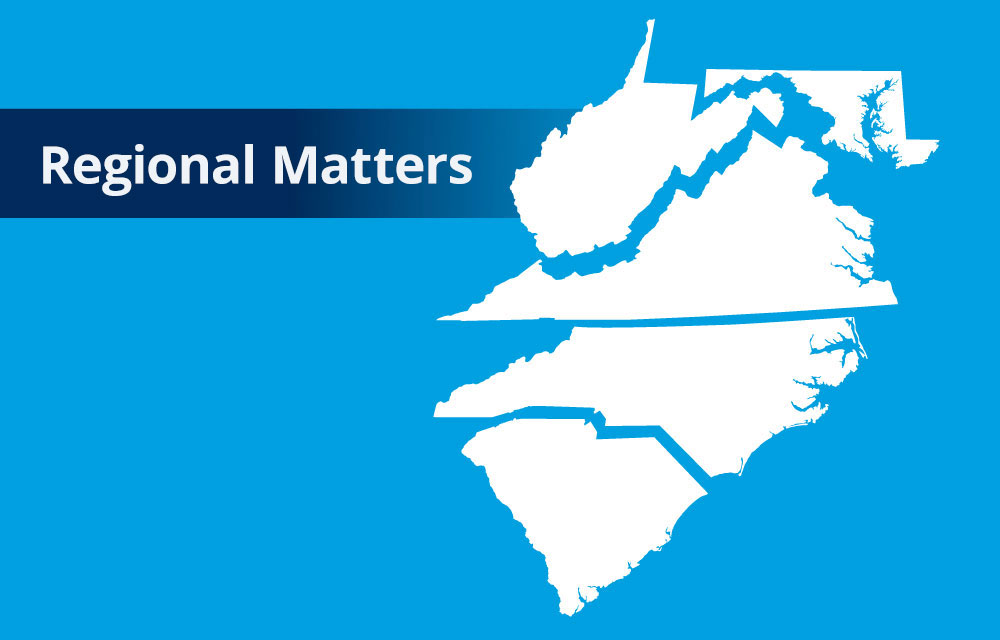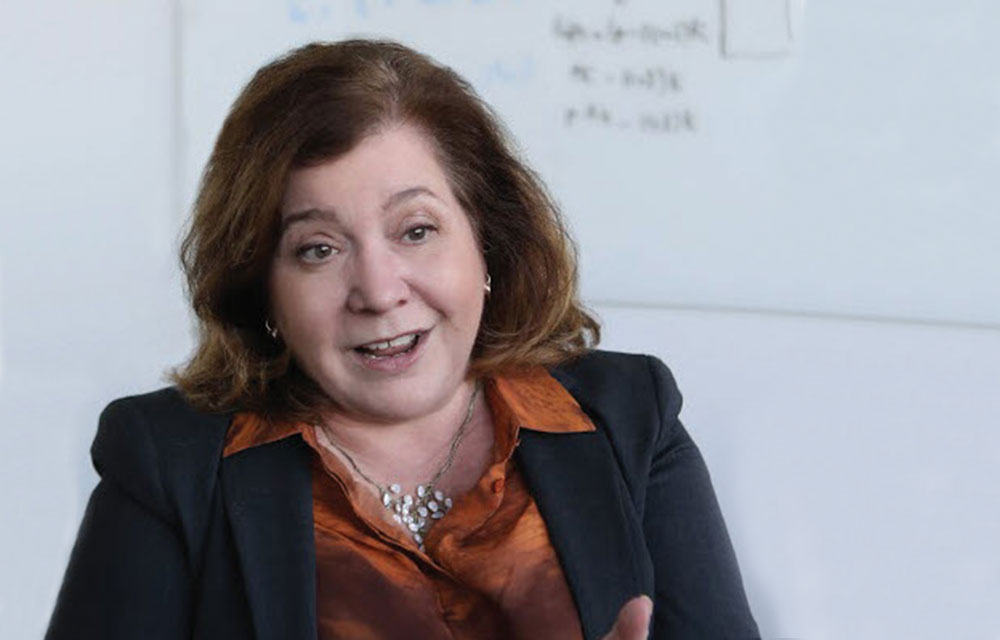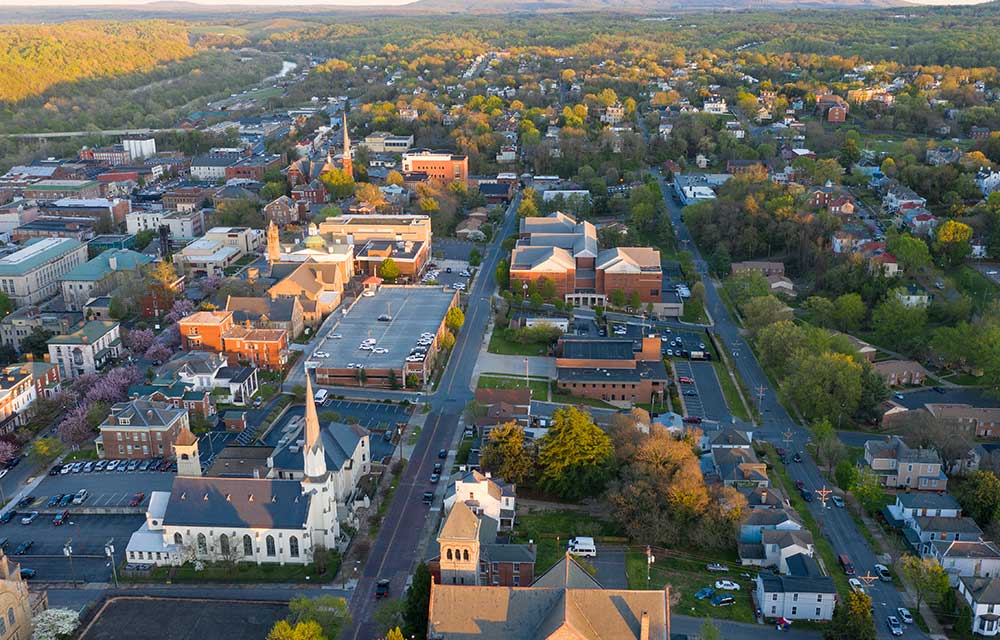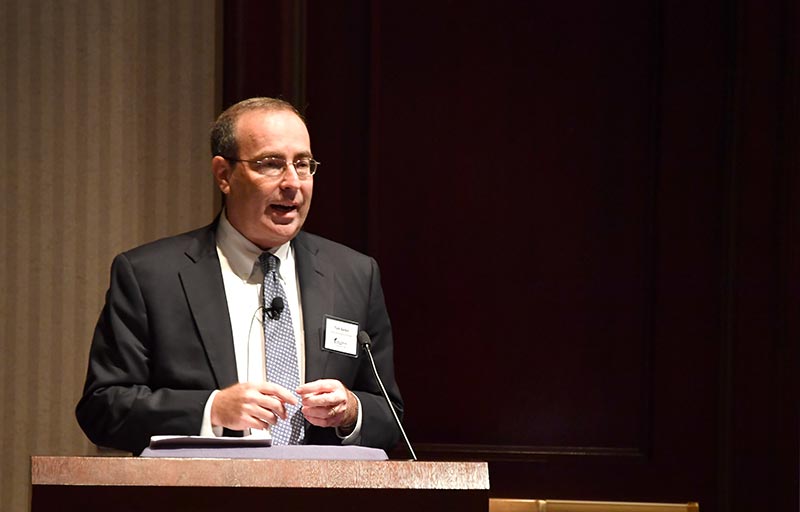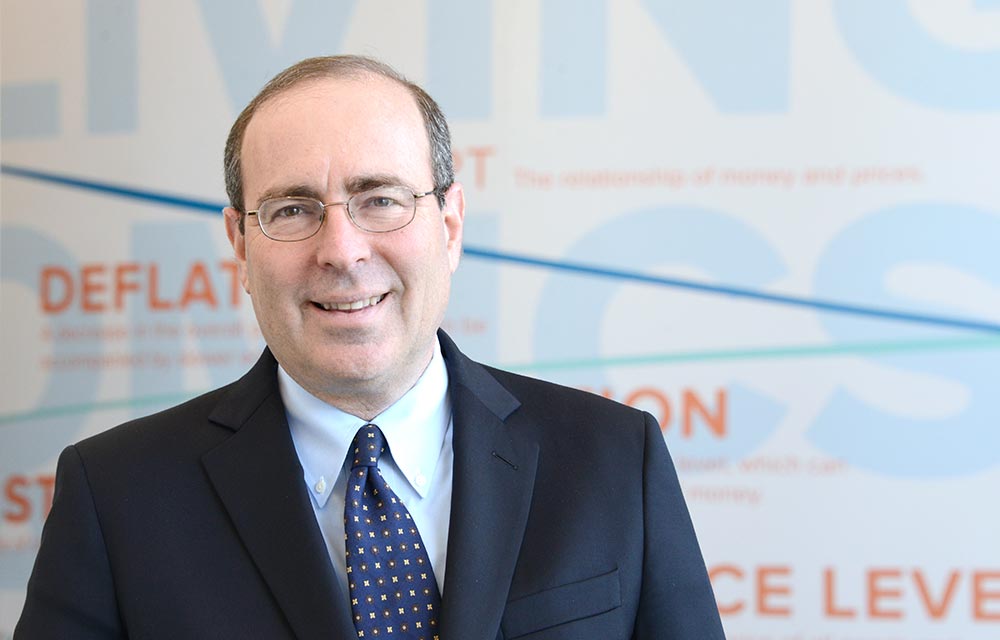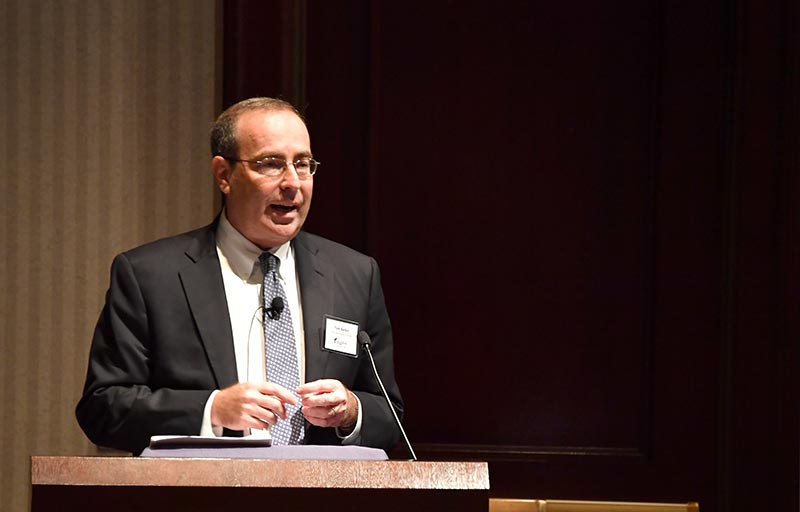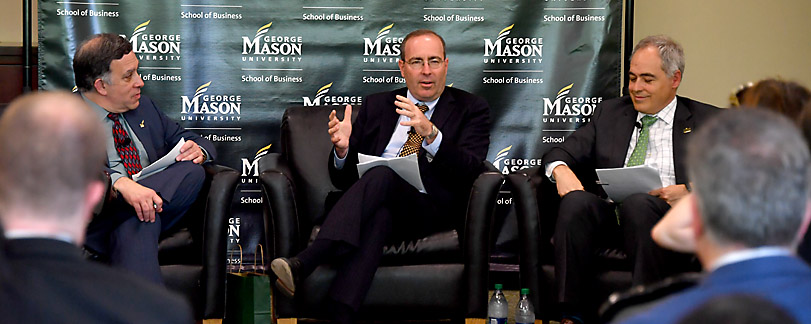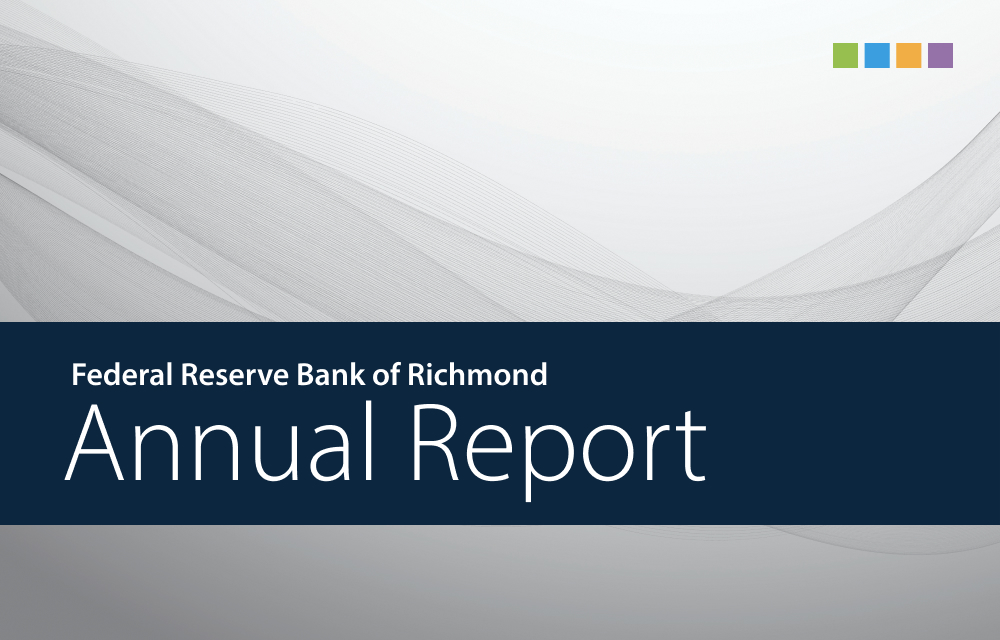Economist Raghuram Rajan on leading a central bank, creating a digital payment system, and India's future in professional services.
Human Capital and Labor

Labor force participation, wages and the unemployment rate are important indicators of the overall health of the economy.
 Updating Results
Updating Results
With sentiment about the labor market appearing to soften, we explore some ways to visualize the breadth of recent jobs growth across industries.
John O'Trakoun
Senior Policy Economist
This post looks into the components of private fixed investment and discusses what recent monthly data could be telling us for the outlook of this piece of GDP.
John O'Trakoun
Senior Policy Economist
This post explores how changes in total population, out-of-the-labor-force population, and unemployment explain employment growth across the Fifth District's rural counties.
Adam Scavette
Regional Economist
What are early studies suggesting about how AI may impact labor productivity?
Being laid off often leads to worse future employment outcomes. A mismatch between the laid-off worker's skills and the local job market can play a significant role in this effect.
Results from the Richmond Fed's May monthly business surveys indicate that for now, firms report employment gains that are driven by increased hiring more than declining separations.
Sonya Ravindranath Waddell
Vice President
Negative impacts seem to be more muted than expected, and some firms say RTO increased employment.
The Richmond Fed's Center for Advancing Women in Economics launched a fellowship program this year as part of its multifaceted approach to raising the visibility of women economists.
Most native U.S. workers seem to benefit from having immigrant coworkers.
Not everyone continues to progress into better-paying jobs.
Following the expansion of unemployment insurance during COVID-19, researchers found that there are different effects for low-wage businesses and high-wage businesses, as well as for different UI policies.
Anxiety about possible job loss appears to be associated with actual changes in worker behavior, lowering the frequency of job switching in the economy.
John O'Trakoun
Senior Policy Economist
Over the course of the 20th century, tipping went from rare and reviled to an almost uniquely American custom. We still like to complain about it.
We study how random variation in the availability of highly educated, foreign-born workers impacts firm performance and recruitment behavior.
Parag Mahajan, Nicolas Morales, Kevin Shih, Mingyu Chen and Agostina Brinatti
Richmond Fed economist Nicolas Morales shares his research on immigration policy and how the regulation of the flow of information technology workers from India to the United States during the 1990s benefited both countries' IT sectors.
The effects of monopsony seem to be getting more attention recently.
Our March business surveys included special questions on return-to-office policies and on-site expectations four years after the pandemic motivated a rapid conversion to remote work for a portion of jobs.
Emily Wavering Corcoran
Senior Manager
This article covers the state-level employment data release from the Bureau of Labor Statistics for January, written by the Richmond Fed's team of regional economists.
Small business performance indicators suggest that consumer demand is resilient and price pressures remain high despite inflation trending down. Measures like these can offer insights into the overall economy's state.
John O'Trakoun
Senior Policy Economist
The Richmond Fed business survey results suggest that wage growth is slowing, and firms expect a return to pre-COVID-19 levels over the next year.
Since 2021, there has been a large increase in both the size of the population with disabilities and the disabled labor force participation rate. Expansion of remote work opportunities seems to have contributed to this growth.
John O'Trakoun
Senior Policy Economist
Yaa Opoku-Agyeman of the Bureau of Labor Statistics and Rachel Lee of Uber Eats talk about their careers as economists and how they have applied their research and analysis skills to address everyday issues.
The increasing share of foreign-born immigrant workers is an important influence on today's labor market landscape. The outlook is highly uncertain if this trend will continue.
John O'Trakoun
Senior Policy Economist
Due to an increase in labor productivity, strong wage growth is coexisting with encouraging signs of inflation in recent readings. However, productivity growth has historically shown to be volatile.
John O'Trakoun
Senior Policy Economist
Richmond Fed economists Andreas Hornstein and Marios Karabarbounis discuss their research on unemployment insurance (UI), most recently on the disincentive effects of the substantial expansion of UI benefits during the COVID-19 pandemic.
Several factors include labor market participation, business cycle volatility and responsiveness to the underlying economic environment.
The Richmond Fed's Rural Investment Collaborative will train 20 rural leaders how to create successful proposals for community funding.
Labor force participation among older workers is on the rise. Concerns about the sustainability of their finances may explain this happening.
John O'Trakoun
Senior Policy Economist
Had U.S. immigration been more restrictive, the IT sectors in both the U.S. and India might have been worse off.
Gaurav Khanna and Nicolas Morales
If good workers remain hard to find, wages could rise further, pressuring margins and prices in turn. So it's important to understand what's happening in the labor market, and where it may go from here.
Tom Barkin
President and Chief Executive Officer
The authors aimed to see whether the benefits of unemployment insurance programs outweigh the incentive to look for a new job when sources of wealth inequality are incorporated.
Brennan Merone
CEOs have recently been more insistent on return to office, which is a mixed bag of results. Deal making and spreading the rewards between employers and workers could make the shift less controversial.
Do higher-ability workers naturally find their way to higher-productivity firms?
Claudia Macaluso discusses the surge in workers doing their jobs at home during the COVID-19 pandemic and the ongoing effects of the remote work option on labor markets and the economy as a whole. Macaluso is an economist at the Federal Reserve Bank of Richmond.
The Center for Advancing Women in Economics discusses how representation can improve.
Upcoming Event: What do Uber and the Federal Reserve have in common? They both hire economists! Did you know that some of your favorite brands also hire economists? But what do economists actually do? Registration required.
The Richmond Fed Community Conversations team visited two South Carolina counties that are partnering with schools to prepare a skilled workforce.
The Richmond Fed hosted two programs on November 15 that unveiled a new approach to measuring the success of community colleges.
Firms are planning to maintain or increase their workforce in 2024, despite persistent hiring challenges and a recent downturn in short-run expectations. But how would this change if demand decreased unexpectedly?
Jobs held by temporary workers aren't included in the official tally of job creation and job destruction, which leads to significantly underestimating the magnitude of labor market flows.
This paper provides independent estimates of the disincentive effects arising from the largest expansion of UI in U.S. history, the pandemic unemployment benefits.
Andreas Hornstein, Marios Karabarbounis, André Kurmann, Etienne Lalé and Lien Ta
Is it possible durable goods spending will settle above the pre-pandemic trend line? If so, what might this consumption shift mean for the aggregate economy?
John O'Trakoun
Senior Policy Economist
Richmond Fed leaders and Federal Reserve Governor Michelle Bowman heard business and community leaders' perspectives on the state of the local economy.
The Richmond Fed Community Conversations team learned about the economic diversity in Virginia's Northern Neck during a recent visit.
We regularly report the quantitative results from the Richmond Fed business surveys, but participants' comments also provide useful context for changes in local business conditions.
Jason Kosakow, Nicholas Haltom and Sonya Ravindranath Waddell
Richmond Fed president Tom Barkin and Federal Reserve Board Governor Michelle Bowman will lead a discussion about the lingering impact of the pandemic on the economy and the workforce. The general public is invited to listen in, via livestream, as Barkin, Bowman and several special guests explore the challenges and opportunities that exist as the region served by the Richmond Fed continues the transition to a new normal.
Santiago Pinto provides evidence of learning losses among K-12 students during the COVID-19 pandemic. He also discusses the causes, distribution and consequences of these losses. Pinto is a senior economist and policy advisor at the Federal Reserve Bank of Richmond.
In this article, we look at labor market activity within the Capital Beltway over the past three years to assess what might be contributing to the slower growth north of the Potomac River.
Adam Scavette and Keith Waters
President Tom Barkin explores what’s happening in the labor market and how it could impact the path ahead.
Tom Barkin
President, Federal Reserve Bank of Richmond
In this week's post, we look at the impact of unions on wage gains for workers and what trends suggest for the road ahead.
John O'Trakoun
Senior Policy Economist
Stephanie Norris explains the concept of social capital, its value in the economic development of communities, and the challenges of measuring it. Norris is a senior research analyst at the Federal Reserve Bank of Richmond.
Many women face the balancing act of managing a successful professional life with the societal expectations that come with being a mother. What impact might this have on a woman's career?
Now that the pandemic has tightened the labor market further, smaller communities are going to have to figure out how to put their best foot forward.
Tom Barkin
President and Chief Executive Officer
Bank leaders spent time with leaders in Anne Arundel County in mid-July and Caroline, Talbot and Dorchester counties in mid-August.
Workers seem to be in favor, but urban cores may hurt as a result.
Although our surveys show signs that the labor market may be cooling, many Fifth District firms continue to report difficulty finding workers with the right skill sets.
John Bailey Jones discusses his recent research on the relationship between marital status and the labor force participation of men. Jones is vice president of microeconomic analysis at the Federal Reserve Bank of Richmond.
In our dynamic economy, new businesses are opened, and older businesses shut down continually over time. How does the BLS account for this churn when reporting jobs growth?
John O'Trakoun
Senior Policy Economist
As the economy continues to normalize from the shock of the pandemic, what changes have we seen in terms of mothers' labor force participation?
Erin Henry and John O'Trakoun
Severe weather shocks can have long-lasting impacts on the macroeconomy.
After two years of tightness, many labor market measures have made notable progress toward reaching more normal levels. But we might still have some time before we see the same for wage growth.
Nicholas Haltom and Sonya Ravindranath Waddell
The Richmond Fed's Community Conversations team discovered a similar focus on workforce development and affordable housing in two regions of South Carolina.
Restrictions on immigration could cause production to shift away from the U.S. to other countries.
Andy Bauer, Renee Haltom and Matt Martin share what their business contacts have told them about regional economic conditions in the Fifth District.
The labor market has surprised economists and forecasters with its resilience. Data from our business surveys indicate that the Fifth District labor market may be cooling.
The Richmond Fed Community Conversations team visited Wythe County to explore the region's promises and possibilities.
The inaugural Marvin Goodfriend lecture, given by Hugo Hopenhayn, discussed how intellectual property rights must trade off incentives for innovation and knowledge diffusion.
The most recent District Dialogues program explored ways that extreme weather is affecting the economy and Fifth District communities.
Researchers covered topics including digital advertising, R&D allocation, production networks, and knowledge creation and diffusion.
John Mullin and Matthew Wells
Last year, the Richmond Fed had over 1,700 community engagements — meetings with bankers, business and community leaders, workers, and public officials. These conversations help us see the region's economy more clearly.
Tom Barkin
President and Chief Executive Officer
Blandin, Jones, and Yang sought to answer whether men decide to spend more hours working after becoming married, or whether these men are already working more hours before they get married.
Erin Henry
Social capital — the strength of social networks within communities — can be important to economic mobility. We look at how this measure varies for communities across our district.
Hugo Hopenhayn discusses his research on the factors that affect the entry and exit of firms in a market, as well as the reallocation of labor and other resources that results from this "creative destruction." Hopenhayn is a professor of economics at UCLA and a long-term consultant at the Federal Reserve Bank of Richmond.
This paper evaluates the welfare effects of unemployment insurance in general equilibrium using a life-cycle model.
The Richmond Fed's Community Development team connected organizations on Maryland's Eastern Shore with potential funders during a recent Investment Connection program.
Wage-price pass throughs may help explain why core goods inflation has risen so much faster in the current expansion than in previous ones.
Changes in unemployment appear to be strong recession predictors, especially when combined with lagged term spreads.
Our preliminary findings suggest that, across industries, the decline in job openings may be more related to hiring challenges rather than quit rates.
John O'Trakoun
Senior Policy Economist
President Tom Barkin shares how small towns in the Fifth District are putting their best foot forward to attract talent.
Tom Barkin
President, Federal Reserve Bank of Richmond
Jason Kosakow and Sonya Waddell discuss the expectations of regional and national business leaders about the economy, based on responses to the CFO Survey and the Federal Reserve Bank of Richmond's regional business surveys during the first quarter of 2023.
Two forces may be working against the long-term unemployed in finding new jobs.
Will strong hiring continue in the leisure and hospitality industry?
John O'Trakoun
Senior Policy Economist
Unemployment has dropped and is now basically at pre-pandemic levels. Yet labor force participation has been slow to return.
Tom Barkin
President and Chief Executive Officer
Moves toward stable inflation and maximum employment can be in conflict in the short term.
Some workers may continue to see larger than normal pay increases as wage differentials across sectors revert to their pre-pandemic norms. These increases, however, aren't distributed evenly across sectors.
Julian Kikuchi and John O'Trakoun
Sierra Latham and Sarah Gunn discuss the current shortage of teachers nationally and in the Fifth Federal Reserve District, how supply-demand forces have contributed to this labor market gap, and what is happening in response. Latham is a senior research analyst and Gunn is director of economic education at the Federal Reserve Bank of Richmond.
Married men work substantially more hours than men who have never been married, even after controlling for observables. This Working Paper delves into possible explanations for these results.
Adam Blandin, John Bailey Jones and Fang Yang
Among the topics discussed were income growth volatility, AI's impact on productivity and how housing price changes affect young businesses.
Claudia Macaluso and Sonya Ravindranath Waddell discuss recent challenges in finding and retaining workers, and how businesses have changed their recruitment tactics, adjusted wages, and made other changes in response to these challenges. Macaluso is an economist and Waddell is a vice president and economist at the Federal Reserve Bank of Richmond.
Results from a recent national Fed survey show that community development financial institutions (CDFIs) and the communities they serve are facing less severe disruptions than last year. Still, staffing and other challenges are preventing CDFIs from fully meeting growing demand for their products and services.
Hailey Phelps
University of Chicago economist on remote work, changes in recruiting, and business startups after the pandemic.
In the past few years, job changing in the United States — workers leaving their current employers for new ones — seems to have been on the rise. This development, often called the "Great Resignation," has attracted much attention, but the reasons behind it are far from clear.
Abhimanyu Banerjee
Jason Kosakow and Santiago Pinto describe how survey data is gathered and used to assess regional and national economic conditions. Kosakow is survey director and Pinto is a senior economist and policy advisor at the Federal Reserve Bank of Richmond.
President Tom Barkin explores whether labor will continue to be in short supply, and what that could mean for the U.S. economy.
Tom Barkin
President, Federal Reserve Bank of Richmond
Monetary policy, marriage, college admissions, and discrimination and socioeconomic outcomes were among the topics discussed at our recent conference.
While more than a third of businesses expect to expand their workforce in the coming year, some firms have started to reduce headcount by not replacing outgoing workers. Most businesses would take that approach, or keep employment steady, if demand softened in the near future.
Joseph Mengedoth
Regional Economist
How related are wages and prices, and does the current environment mean such a relationship has changed?
John O'Trakoun and Brennan Merone
For some underperforming employees, employers might prefer using suspension rather than outright termination.
Pandemic-era unemployment insurance affected recoveries of low-wage job markets and high-wage job markets differently.
Andreas Hornstein, Marios Karabarbounis, André Kurmann and Etienne Lalé
The Recompete Pilot Program intends to boost economic competitiveness in selected underperforming areas by dispersing grants to fund proposed infrastructure, workforce, and business development activities.
Adam Scavette
Regional Economist
Over the past year, firms have had difficulty finding workers. Recent evidence from Fifth District business surveys indicates the difficulty is shifting from lower- to higher-skilled hires.
Nicholas Haltom and Jacob Walker
Labor force participation in Maryland and Virginia is down considerably compared to 2019, but different age and gender groups have fallen out of the labor force in the two states.
Joseph Mengedoth
Regional Economist
Data suggest that labor market tightness has meant an increased number of open jobs per unemployed worker and heightened employer recruiting effort per vacancy.
States and school districts are using a variety of policies – including financial incentives – to try to combat a teacher shortage.
A brief review of the development of the Hornstein-Kudlyak-Lange Non-Employment Index, an alternative to the standard unemployment rate that includes all non-employed individuals and accounts for persistent differences in their labor market attachment.
John Mullin
President Tom Barkin explores some of the crucial segments lagging behind in the jobs recovery.
Tom Barkin
President, Federal Reserve Bank of Richmond
Andy Bauer reviews economic conditions in Maryland, the District of Columbia and West Virginia, based on recent conversations with local contacts and analysis of the data. Bauer is a vice president and regional executive at the Richmond Fed, with responsibility for business and community engagement in these parts of the Fifth Federal Reserve District.
The elevated number of job openings in recent months have been a very stark signal of labor market tightness. But some signs may be pointing to that tightness starting to ease.
Brennan Merone and John O'Trakoun
How competitive is the U.S. labor market? Answering this question quantitatively is helpful for understanding how wages are affected by labor market power, and thus for understanding how workers will be affected by labor policy choices.
Abhimanyu Banerjee
While several indicators have pointed to a recent slowdown in economic activity, one that uses unemployment rates to gauge recession probabilities may offer new insights.
John O'Trakoun
Senior Policy Economist
In a world where employers are struggling to find workers, facilitating meaningful work and competitive pay for previously incarcerated individuals could improve economic outcomes both for the individuals and their communities.
Laura Dawson Ullrich
Senior Regional Economist
How does immigration policy impact economic growth? Do firms that hire more skilled immigrants perform better? These and other questions were addressed during a recent Richmond Fed conference.
Abhimanyu Banerjee
Diffusion indexes can help summarize survey responses, but they have some limitations.
Andreas Hornstein and Thomas Lubik discuss their research on changes in the labor market since the pandemic. Hornstein and Lubik are senior advisors at the Richmond Fed.
Numerous factors — including population growth, education, housing, transportation, child care, health, and broadband availability — are shaping the differences in employment outcomes between rural and urban communities.
Standard life-cycle models of portfolio choice suggest that individuals should participate in the stock market throughout their lives. Yet the data show that this is not typically the case early in life.
Brandon Fuller
President Tom Barkin discusses how firms can optimize the hybrid work environment.
Tom Barkin
President, Federal Reserve Bank of Richmond
When immigration is restricted in rural areas, native workers don't seem to fill the jobs left empty.
Recent reports revealed strong growth in hiring and wages for April. But is that growth enough to keep up with inflation?
John O'Trakoun
Senior Policy Economist
Unlike in other recessions, women's labor force participation was impacted more than men's. What impact did child care have?
In this essay, we describe Marvin Goodfriend's Industrial Development model and ponder its lessons for contemporary policy discussions.
How did unemployment insurance expansion affect recovery from the pandemic-induced recession? What are the effects of federal minimum wage hikes? A recent research conference addressed these questions and more.
John Mullin
The unemployment rate is close to pre-pandemic lows, and job openings are at record highs. Yet, participation and employment rates are still below pre-pandemic levels.
In our March business survey, we found that firms continue to struggle finding workers across skill levels, particularly in the low- to mid-skill range.
While the unemployment rate has yet to fall to its pre-pandemic level, another measure of labor market tightness has reached levels not seen since the 1970s — job openings per unemployed person.
John O'Trakoun
Senior Policy Economist
In this paper, we examine the labor market effects of the Neighbourhood Renewal Fund, which targeted eighty-eight of the most deprived areas in England during the early 2000s as part of the Labour Government's National Strategy for Neighbourhood Renewal.
Robert Calvert Jump and Adam Scavette
Revised historical monthly employment and unemployment data provide new clarity on the track of labor market recovery in Fifth District states.
Nicholas Haltom and Jacob Walker
Renee Haltom, vice president and regional executive, reflects on key insights from the District Dialogues event held Feb. 8, 2022. The discussion focused on changes in the nature of work, the workforce and the skills needed, and how workers and employers are responding.
President Tom Barkin discusses how the labor shortage story differs across key segments of the economy.
Tom Barkin
President, Federal Reserve Bank of Richmond
Yale University economist on developing countries, measuring economies by satellite, and the learning crisis.
The pandemic has worsened a long-standing national shortage of nurses. Rural communities face the greatest challenges.
Fifth District firms report that two years into the pandemic, they still cannot provide enough goods and services to completely meet customer demand.
Remote work options seem to go hand in hand with greater geographic reach in recruitment efforts for some firms.
Steven J Davis, Claudia Macaluso and Sonya Ravindranath Waddell
For the 50th episode of the podcast, hosts Jessie Romero, Charles Gerena and Tim Sablik use previous episodes to explore how labor markets are shaped by the economic choices we make throughout our lifetimes, from childhood to adulthood to old age.
Despite improvements in the unemployment rate and labor force participation, one measure indicates continued hiring challenges in the private sector: the hires-per-job opening ratio.
John O'Trakoun
Senior Policy Economist
There are a lot more people who say they aren't working due to COVID-19, according to a recent survey. However, other data indicates that most of those workers remain in the labor force.
Conner Mulloy and John O'Trakoun
President Tom Barkin reflects on lessons learned last year and looks forward at what this year could look like for the U.S. economy.
Tom Barkin
President, Federal Reserve Bank of Richmond
Workers are not fully compensated for their marginal contributions to their employers' revenues, and employers' market power has been increasing since the early 2000s.
Mark Bils of the University of Rochester and Niklas Engbom of New York University discuss their research on how easily labor is substituted or shifted between jobs and its implications for policies to bolster human capital.
While nonfarm payrolls increased only modestly in December, both monthly and high-frequency data on job openings bode well for upcoming employment reports.
John O'Trakoun
Senior Policy Economist
Fifth District firms increase employment and raise wages in response to a changing economy.
Jason Kosakow
Survey Director
Despite an impressive drop in the unemployment rate in November 2021, looking at the breakdown of the unemployed shows that the labor market is not back to normal.
John O'Trakoun
Senior Policy Economist
We use a detailed establishment-level dataset from Germany to document a new dimension of firm heterogeneity: large firms spend a higher share of their wage bill on immigrants than small firms.
Agostina Brinatti and Nicolas Morales
The Paycheck Protection Program was intended to help business owners sustain their employees' wages during the pandemic.
A surge of interest in starting new businesses could reverse a long-running drought.
For many observers, the most exceptional aspect of the COVID-19 economic recovery has been the unprecedented number of unfilled jobs openings.
Andy Bauer, Matt Martin and Renee Haltom reflect on the past year, sharing what they have learned from their contacts about the national and regional economies that they follow.
The rebound in employment from pandemic lows varied considerably across regions and sectors.
Andrew Foerster, Nick Garvey and Pierre-Daniel G. Sarte
In a tight labor market, Fifth District firms struggle to attract qualified workers.
Jason Kosakow
Survey Director
Government transfers may allow households to pull back from work to take care of loved ones or engage in other valued activities.
The Bureau of Labor Statistics started releasing state-level data from the Job Opening and Labor Turnover Survey (JOLTS), giving a unique perspective on labor demand around our District.
Joseph Mengedoth and Jacob Walker
Less-educated White men who are incarcerated at least once have a higher survival probability than those who are never incarcerated.
In the post-COVID-19 labor market, there is still an inverse relationship between the unemployment rate and the job openings rate, expressed as the Beveridge curve. But it takes a lot more openings to get to the same level of unemployment. This shift suggests a high degree of labor market mismatch.
John O'Trakoun
Senior Policy Economist
The Beveridge curve — which measures the inverse relationship between the unemployment and vacancy rates — has shifted significantly outward and is much steeper than in pre-COVID times.
President Tom Barkin discusses how we can connect more women with employment.
Tom Barkin
President, Federal Reserve Bank of Richmond
Increasing labor competition may drive wages down, but natives and immigrants specializing in working for different firms helps offset this effect.
Nicolas Morales and Agostina Brinatti
President Tom Barkin talks about who is on the sidelines of the labor market, what’s keeping them there, and how we can remove barriers in their way.
Tom Barkin
President, Federal Reserve Bank of Richmond
Average hourly earnings continue to grow strongly. With inflation running high, however, real wage growth has been more muted. Inflation has even outpaced wage growth in a few sectors.
John O'Trakoun
Senior Policy Economist
This post explores lagged recovery in labor force participation for Black and Hispanic women that started at the onset of the COVID-19 recession.
Katie Daniluk and Sierra Latham
President Tom Barkin discusses forces that could keep quits elevated in the months to come and what that could mean for employers and the economy.
Tom Barkin
President, Federal Reserve Bank of Richmond
There could be multiple explanations for why more workers are staying on the sidelines compared to the pre-COVID-19 days. One reason could be that some people have reconsidered the costs and benefits of working.
John O'Trakoun
Senior Policy Economist
President Tom Barkin discusses how employers might change their hiring practices to bring more people into the labor market as the recovery continues.
Tom Barkin
President, Federal Reserve Bank of Richmond
Manufacturers have recently seen an increase in orders, but disruptions in the supply chain have made meeting demand a challenge.
Roisin McCord and Alexander Nikolov
Recent Richmond Fed surveys shed light on how employers attempt to fill jobs.
Steven J Davis, Claudia Macaluso and Sonya Ravindranath Waddell
Unemployment insurance seems to help smooth consumer spending after a job loss, but there's disagreement on how much it discourages people from finding new jobs.
Renee Haltom and John O'Trakoun explore recent wage inflation within the context of the short-term challenges of hiring workers in certain industries as well as longer term trends in income growth.
The two main employment surveys can present differing views of the health of the labor market in any given month, adding to the challenges of determining how far the economy has recovered from last year's severe downturn.
John O'Trakoun
Senior Policy Economist
Many states, including some in the Fifth District, have enacted legislation in the last year to increase the minimum wage, and those increases will have both direct and indirect effects on workers, households, and businesses in the District.
University of Texas at Austin economist on wage growth, labor's share of income, and the gender unemployment gap
The reservation wage increased 26 percent between 2020 and 2021 for those making less than $60,000. The impact of the pandemic experience and expectation shifts could be contributing.
Tom Barkin
President and Chief Executive Officer
Surveyed Fifth District firms are raising wages at an above normal pace as they struggle to fill open positions.
Roisin McCord
Employers are reporting they are unable to find workers. But is every industry experiencing the same difficulties, and are the industries having more trouble raising wages in response?
John O'Trakoun
Senior Policy Economist
Mariacristina De Nardi of the University of Minnesota discusses her research on the effects of tax policy and Social Security benefits on women's labor supply.
A recent Richmond Fed conference covered housing, Social Security claiming, savings and labor supply related to older households.
President Tom Barkin discusses the factors keeping workers out of the labor force—and how employers are responding.
Tom Barkin
President, Federal Reserve Bank of Richmond
We study the implications of incarceration for the earnings and employment of different groups, characterized by their race, gender, and education.
President Tom Barkin shares his perspective on recent economic data and the outlook for inflation.
Tom Barkin
President, Federal Reserve Bank of Richmond
President Tom Barkin spoke to a joint meeting of Hispanic Chambers of Commerce about the challenges and opportunities facing Hispanic workers.
Tom Barkin
President, Federal Reserve Bank of Richmond
El presidente Tom Barkin habló en una reunión conjunta de Cámaras Hispanas de Comercio sobre los desafíos y oportunidades que enfrentan los trabajadores hispanos.
Tom Barkin
President, Federal Reserve Bank of Richmond
Nicolas Morales discusses the interplay between immigrants and native-born workers in labor markets and how immigration can contribute to U.S. productivity.
Andy Bauer discusses West Virginia's progress in recovering from the economic downturn during the COVID-19 pandemic.
Targeted interventions toward COVID-19, rather than universal stay-at-home orders, might have resulted in less economic damage and fewer deaths, according to one researcher.
President Tom Barkin discusses the factors influencing wage growth in the wake of the pandemic.
Tom Barkin
President, Federal Reserve Bank of Richmond
What explains diverging employment outcomes for college graduates and older workers? Read more in President Tom Barkin’s latest essay.
Tom Barkin
President, Federal Reserve Bank of Richmond
When rolling out vaccines to combat a pandemic, focusing first on those with intermediate vulnerability provides the greatest returns to society.
Joshua Weiss and Nikhil Vellodi
Recent legislation has again highlighted the U.S. welfare system. This EB summarizes the welfare system and a "work bias" embedded in many U.S. welfare programs.
Millions of Americans face diminished earnings and employment prospects years after they have spent time in prison. Grey Gordon and Urvi Neelakantan share their insights.
Does gender diversity improve team performance? How should vaccines be allocated to combat a pandemic? How do employers affect how immigration impacts native workers? These were among the questions discussed by researchers during a recent virtual research workshop.
Over the past 50 years, male labor force participation in the U.S. has fallen over 10 percentage points. What are the factors behind this decline?
Laura Dawson Ullrich
Senior Regional Economist
How much reshuffling of businesses and residents will we see among cities, suburbs, and rural areas? The answer will have important implications for local economies.
Tom Barkin
President and Chief Executive Officer
Many countries have industrialized and grown rapidly by adopting modern technologies. Why don't poor countries adopt more productive technologies? Is there a role for policies that coordinate technology adoption?
Francisco Buera, Hugo Hopenhayn, Yongseok Shin and Nicholas Trachter
Senior policy economist Arantxa Jarque discusses the importance of having diverse voices represented at the Federal Reserve and in the economics profession in general.
President Tom Barkin spoke about investments to help address long-term disparities exposed by COVID-19.
Tom Barkin
President, Federal Reserve Bank of Richmond
President Tom Barkin spoke about the potential for COVID-19 to leave long-lasting scars on the economy—and how policy can help.
Tom Barkin
President, Federal Reserve Bank of Richmond
This brief discusses the main contributions that college-educated immigrants make to U.S. productivity growth, such as providing scarce skills that supplement and complement skills of native workers, contributing disproportionately to innovation and promoting job creation in the United States by foreign-based multinational corporations.
Claudia Macaluso looks at the history of the United States' welfare system and its effectiveness in combating poverty during recessions and the recent pandemic.
Marios Karabarbounis, Nicholas Trachter, and Adam Blandin discuss using high-frequency datasets to track the economy's health during the COVID-19 pandemic.
High labor market churn in the COVID-19 recession may exacerbate barriers to sustained wage growth for workers in high-turnover service sector jobs.
Labor force participation took a big hit from the pandemic. How then should we interpret states' reported unemployment rates?
Nicholas Haltom and Sonya Ravindranath Waddell
President Tom Barkin discusses the importance of training the next generation of infrastructure workers.
Tom Barkin
President, Federal Reserve Bank of Richmond
Andy Bauer provides an update on economic conditions in Maryland as the state recovers from the severe downturn caused by the COVID-19 pandemic.
The most recent stimulus bill extends many 2020 changes to the unemployment insurance program but reduces the supplement to weekly benefits.
President Tom Barkin talks about the pandemic’s lasting influence on office life.
Tom Barkin
President, Federal Reserve Bank of Richmond
Ann Macheras discusses the state of the economy in the District of Columbia, Maryland, Virginia, West Virginia, and North Carolina and South Carolina.
Tiffany Hollin-Wright and Erika Bell explain "benefits cliffs" ― when workers receiving public assistance earn a raise and then are disqualified from receiving government help.
Firms report how the coronavirus is influencing their employment levels, hiring plans, and wages in our annual survey.
Toan Phan talks about his research on the effects of climate change on economic growth and discusses other work on this important topic.
Job postings, employment by income level, and business formation data tells the story of labor market activity during the economic downturn caused by COVID-19.
Jacob Crouse
Renee Haltom shares what she has been hearing about Virginia's economy, especially in light of the COVID-19 pandemic.
Traditional employment data are often lagged, so during the COVID-19 pandemic, economists and policymakers shifted to high-frequency data that may better capture rapidly changing conditions.
Joseph Mengedoth
Regional Economist
Much of the previous economic research on the aftermath of recessions has focused on their short-term effects on earnings and jobs. New research suggests that with longer-term consequences, workers' earnings, health and family outcomes may be affected.
Emily Green
University of Toronto economist on managing pandemics, allocating vaccines, and low-cost prediction with artificial intelligence.
Richmond Fed president Tom Barkin spoke about workforce barriers at a virtual summit hosted by West Virginia Women Moving Forward.
Tom Barkin
President, Federal Reserve Bank of Richmond
Do the timing and length of lockdowns explain state-level differences in unemployment?
Marios Karabarbounis, Reiko Laski, James Lee and Nicholas Trachter
Richmond Fed president Tom Barkin discusses the loss of service-industry jobs and the effects on younger workers.
Tom Barkin
President, Federal Reserve Bank of Richmond
Policy changes and the unique nature of the COVID-19 pandemic may impact the way labor market health is evaluated going forward.
Lucas Moyon and Laura Dawson Ullrich
The COVID-19 pandemic has caused an unprecedented amount of job loss, yet only a few industries have accounted for a significant portion of it. How do these industry-specific trends in the Fifth District compare to the U.S. overall, and is there any relationship between recent job recovery and states’ phased reopening plans?
Lucas Kenley
The number of hours worked by hourly employees dropped considerably in the United States and the Fifth District in March but showed signs of recovery in May and June. A look at high frequency data shows how hours worked by hourly employees in the food and drink, leisure and entertainment, and retail industries have been impacted during the COVID-19 pandemic.
Jacob Crouse
Job postings dropped considerably in the United States and Fifth District in March and April but showed signs of recovery in May.
Surekha Carpenter and Jacob Crouse
Read President Tom Barkin’s new essay on how supporting families and workers supports the economy’s long-term recovery.
Tom Barkin
President, Federal Reserve Bank of Richmond
Researchers and policymakers are wondering whether the economic losses associated with the COVID-19 pandemic will prove temporary or persistent. Examining the housing crisis of 2006—09 may provide some clues.
As part of the U.S. response to COVID-19, unemployment insurance recipients are receiving increased weekly payments. For many individuals in the Fifth District, these enhanced unemployment benefits are greater than the wages they earned while at work.
As the COVID-19 pandemic rapidly rearranges the U.S. labor market, women have been disproportionately affected.
Abigail Crockett and Nina Mantilla
President Tom Barkin wrote about the potential longer-term impact of COVID-19.
Tom Barkin
President, Federal Reserve Bank of Richmond
In recent weeks, unemployment insurance claims have hit record numbers. But what exactly do unemployment insurance programs cover? And what roles do states play?
Between mid-March and early April, more than 360,000 Virginians filed for unemployment. What does this mean for employment measures and the state's economy?
Sonya Ravindranath Waddell
Vice President
As the COVID-19 pandemic spreads across the country, Americans are taking measures to distance themselves from their communities, both voluntarily and by mandate. What measures have Fifth District jurisdictions taken and what might this mean for the Fifth District economy?
Sonya Ravindranath Waddell and Jacob Crouse
A quantitative model of college enrollment suggests that the value of college access varies greatly across individuals.
Explore how payroll employment growth in Maryland has differed from the nation since the Great Recession in this Regional Matters article.
Northwestern University economist on firms' investment decisions, intangible capital, and the college premium
A special survey on hiring and wages, conducted in November, showed that a majority of Fifth District firms expect to hire or hold payrolls steady and plan to use wage increases to attract and retain workers over the next twelve months.
Joseph Mengedoth
Regional Economist
Richmond Fed President Tom Barkin highlighted strategies for drawing people back into the workforce at the Danville Pittsylvania Chamber of Commerce Institute for Advanced Learning & Research.
Tom Barkin
President, Federal Reserve Bank of Richmond
Richmond Fed President Tom Barkin discussed economic differences between small towns and urban areas at the Investing in Rural America conference.
Tom Barkin
President, Federal Reserve Bank of Richmond
Richmond Fed President Tom Barkin discussed how entrepreneurship can boost economic growth at the West Virginia Chamber of Commerce 2019 Annual Meeting and Business Summit.
Tom Barkin
President, Federal Reserve Bank of Richmond
Richmond Fed President Tom Barkin spoke to the Charlotte Economics Club on women's labor force participation, including trends, challenges and solutions.
Tom Barkin
President, Federal Reserve Bank of Richmond
The labor force participation rate varies considerably across Fifth District jurisdictions, from West Virginia's 53.3 percent to the District of Columbia's 70.4 percent. What is driving the differences among jurisdictions?
R. Andrew Bauer
Vice President and Regional Executive
Recently revised payroll employment data for 2018 showed that fewer jobs were added in the Fifth District than originally reported. The largest downward revisions occurred with data for North Carolina, West Virginia, and Virginia.
Akbar Naqvi
As of December 2018, unemployment rates declined in every county and independent city in the Commonwealth of Virginia from December 2017. But how do the most recent rates compare with previous lows?
Joseph Mengedoth
Regional Economist
Richmond Fed President Tom Barkin spoke January 10, 2019, in Raleigh to the Greater Raleigh Chamber of Commerce at its 2019 Economic Forecast event.
Tom Barkin
President, Federal Reserve Bank of Richmond
Richmond Fed President Tom Barkin spoke January 4, 2019, at the Maryland Bankers Association’s First Friday Economic Outlook Forum in Baltimore.
Tom Barkin
President, Federal Reserve Bank of Richmond
According to a survey conducted in November 2018, many Fifth District businesses plan on increasing employment in the next year and are generally offering higher starting wages for at least some job types.
Joseph Mengedoth
Regional Economist
In 2018, the unemployment rate was at historic lows. Were employers having trouble hiring because there weren't enough workers, or because they had the wrong skills?
Although changes in educational attainment, employment status, and median earnings were inconsistent across Fifth District jurisdictions in 2017, most saw lower unemployment and higher median earnings.
Joseph Mengedoth
Regional Economist
Richmond Fed President Tom Barkin discussed geographic differences between rural and urban areas, workforce development, and mobility at the Reinventing Our Communities conference.
Tom Barkin
President, Federal Reserve Bank of Richmond
Richmond Fed President Tom Barkin delivered remarks to a Federal Reserve conference on minorities in banking.
Tom Barkin
President, Federal Reserve Bank of Richmond
The Richmond Fed looks at the economic impact of the opioid crisis in the Fifth District.
Sonya Ravindranath Waddell
Vice President
Richmond Fed President Tom Barkin spoke to community and business leaders in Roanoke, Virginia, about strategies to boost economic growth.
Tom Barkin
President, Federal Reserve Bank of Richmond
Natural gas production has experienced tremendous growth over the last decade in the U.S. and West Virginia and continues to grow. In West Virginia, six new pipeline projects have been proposed. How will these pipelines service the natural gas market, and how long until they are in service? What has the impact been on job growth and wages?
R. Andrew Bauer
Vice President and Regional Executive
President Tom Barkin spoke at George Mason University in Fairfax, Va. on May 7, 2018.
Tom Barkin
President, Federal Reserve Bank of Richmond
Revised employment data show fewer jobs added in the Fifth District than originally reported. By December 2017 (the most recent month revised), total employment was revised lower by 75,300 jobs or 0.5 percent.
Michael Stanley
December 2017 marked the 10-year anniversary of the start of the economic downturn which would ultimately evolve into the Great Recession. As bad as the Great Recession was nationally, South Carolina's descent into the trough was steeper. And its recovery has been more impressive, particularly in the Charleston and Upstate regions.
In 2016, every Fifth District jurisdiction, along with the nation, saw an increase in the share of the over-25 population with a bachelor's degree or higher. What else changed since 2015?
Joseph Mengedoth
Regional Economist
The Richmond Fed worked with NCEast Alliance to facilitate a business and industry roundtable meeting that focused on payroll employment growth.
The Fifth District Hispanic population has been exhibiting significant growth, but labor market indicators provide insight on income disparity relative to population overall.
The Fifth District has a disproportionately high share of federal government employment and contract dollars, and could be more heavily affected by reductions than other comparable areas.
Michael Stanley
The share of American women in the labor force is slipping even as it rises in the rest of the developed world
Helen Fessenden
How has the Garrett County economy progressed since the Great Recession? How has the labor market improved? Has business activity stabilized?
R. Andrew Bauer
Vice President and Regional Executive
According to conventional wisdom, wealth redistribution boosts output by increasing aggregate consumption. However, while redistributive policies can have a short-run stimulative effect on consumption, their effect on output depends, potentially quite importantly, on the nature of household labor supply.
Kartik B. Athreya, Andrew Owens, Jessie Romero and Felipe F. Schwartzman
Earlier this year, we reported the results of a special survey on hiring and wages. A similar survey was conducted in November ... the results are in.
Joseph Mengedoth
Regional Economist
Virginia gained jobs at a brisk pace during 2015, but the pace slowed during the first five months of 2016 and has only recently picked up again. Employment growth by industry and by metro area varies substantially.
In May, the Richmond Fed added questions to our regular monthly surveys to explore employer opinions on hiring, employee retention, and wage plans.
Aileen Watson
Are the majority of inner cities experiencing a renaissance thanks to rapid gentrification, or is growth limited to a small number of high-technology regions, resulting in inequality among metropolitan areas?
Harvard University economist on the history of women's employment, mapping the gender wage gap, and for-profit colleges
Around the Fed
State governments that recognize the tremendous economic value that aircraft manufacturing can bring their communities are actively courting such plants to bolster their aerospace clusters.
Richmond Fed President Jeffrey M. Lacker addressed the Global Interdependence Center in Sarasota, Florida.
Jeffrey M. Lacker
President, Federal Reserve Bank of Richmond
Richmond Fed President Jeffrey Lacker addressed the Greater Richmond Chamber of Commerce.
Jeffrey M. Lacker
President, Federal Reserve Bank of Richmond
Research Spotlight
Some argue that there's no downside to a higher minimum wage, but others say the poor would be hit hardest
Wendy Morrison
Why job accessibility is limited for some groups and what it means for anti-poverty policies
Frank Muraca
Around the Fed
Why do kids drop out of high school, and what can be done to help them finish?
Longer unemployment benefits often mean longer unemployment spells, but economists say that's not always a bad thing
Presidents Message
Richmond Fed president Jeffrey M. Lacker spoke about the national economic outlook during the Bank’s Regional Forum in Asheville, N.C.
Jeffrey M. Lacker
President, Federal Reserve Bank of Richmond
I study firm characteristics that justify the use of options or refresher grants in the optimal compensation packages for CEOs in the presence of moral hazard.
Arantxa Jarque
Senior Policy Economist
Equilibrium occurs when supply and demand are balanced, a concept that helps policymakers understand the likely effects of a given policy.
Renee Haltom
Vice President and Regional Executive
Richmond Fed President Jeffrey M. Lacker addressed business leaders during a luncheon hosted by the Rotary Club of Charlotte in Charlotte, N.C.
Jeffrey M. Lacker
President, Federal Reserve Bank of Richmond
A great uncertainty in the labor market--high unemployment risk, frequent job turnovers, and an unknown career path--prevents young workers from taking too much risk in the financial market. As labor-market uncertainty is resolved over time, workers start taking more risk in their financial portfolios.
Yongsung Chang, Jay H. Hong and Marios Karabarbounis
Richmond Fed President Jeffrey M. Lacker spoke about the economic outlook Feb. 4, 2014, in remarks to students, faculty and community leaders at Shenandoah University in Winchester, Virginia.
Jeffrey M. Lacker
President, Federal Reserve Bank of Richmond
Richmond Fed President Jeffrey M. Lacker spoke about the economic outlook Jan. 17, 2014, in remarks to the Richmond chapter of the Risk Management Association.
Jeffrey M. Lacker
President, Federal Reserve Bank of Richmond
Richmond Fed President Jeffrey M. Lacker addressed teachers at the Council for Economic Education’s 52nd Annual Conference in Baltimore.
Jeffrey M. Lacker
President, Federal Reserve Bank of Richmond
Reemploying Displaced Workers: Lessons from North Carolina
In a stylized quantitative analysis, we show that the consumption effect dominates, so that unemployment benefits increase per-worker productivity. We also analyze the welfare-maximizing benefit level and find that it decreases as moving costs increase.
David L. Fuller, Marianna Kudlyak and Damba Lkhagvasuren
A new database of online job posting data sheds light on how workers search for jobs.
Lacker speaks at the Charlotte Chamber of Commerce's Annual Economic Outlook Conference.
Jeffrey M. Lacker
President, Federal Reserve Bank of Richmond
In view of the increasing share of long-term unemployment since the 2007-09 recession, we provide an extension of the Shimer (2012) unemployment accounting scheme that allows for both short-term and long-term unemployment and that uses data on the duration distribution of unemployment.
Lacker Addresses Business and Government Leaders in Roanoke, Va.
Jeffrey M. Lacker
President, Federal Reserve Bank of Richmond
Speech before Money Marketeers Sept. 18, 2012
Jeffrey M. Lacker
President, Federal Reserve Bank of Richmond
We show that, whereas during earlier recessions it was sufficient to examine the flows between employment and unemployment to account for the dynamics of the unemployment rate, this was not true in the Great Recession.
Lacker Addresses Business and Community Leaders in Greensboro, N.C.
Jeffrey M. Lacker
President, Federal Reserve Bank of Richmond
Lacker Addresses Dulles Regional Chamber of Commerce, Chantilly, Va.
Jeffrey M. Lacker
President, Federal Reserve Bank of Richmond
Lacker speaks at Southern Growth's 2011 Chairman's Conference in Roanoke, Va.
Jeffrey M. Lacker
President, Federal Reserve Bank of Richmond
Reviews the Bank's operations and includes the article entitled "Systemic Risk and the Pursuit of Efficiency"
Reviews the Bank's operations and includes the article entitled "Inflation and Unemployment: A Layperson's Guide to the Phillips Curve"
Richmond Fed President Jeffrey M. Lacker spoke January 18, 2005 at the Guilford College, University of North Carolina -- Greensboro, FNB Southeast in Greensboro, N.C.
Jeffrey M. Lacker
President, Federal Reserve Bank of Richmond
Reviews the Bank's operations and includes the article entitled "What's Driving Wage Inequality? The Effects of Technical Change on the Labor Market"
We study the behavior of output, employment, consumption, and investment in Germany during the Great Depression of 1928-37. In this time period, real wages were countercyclical, and productivity and fiscal policy was procyclical.
Jonas D.M. Fisher and Andreas Hornstein
Reviews the Bank's operations and includes the article entitled "Mercantilists and Classicals: Insights from Doctrinal History"


